Nuclear Energy
Might be cool to setup a post on other nuclear communities, websites and accounts. Please share your links! I'll update this post ☺️ Reddit: - https://www.reddit.com/r/NuclearPower/ - https://www.reddit.com/r/nuclear/ - https://www.reddit.com/r/fusion/ Discord: - Socialists for nuclear energy: https://discord.com/invite/xSCEZxr - Go nuclear now: https://discord.gg/3mgzWKyB3e - Nuclear science and engineering: https://discord.gg/dPDWyuGJgP Mastodon: - https://greennuclear.online/ Websites: - https://collectifission.nl - leftwingers for nuclear - https://replanet.ngo - an international network of ecomodernists - https://de.nucleopedia.org/ - German language nuclear wiki
Apparently no nuclear energy community existed just yet, so let this be the first 🙂 Some initial rules: 1. Follow the rules of this instance: - No bigotry - including racism, sexism, ableism, homophobia, transphobia, or xenophobia. - Be respectful, especially when disagreeing. Everyone should feel welcome here. - No porn. - No Ads / Spamming. 2. On the solar/wind vs nuclear debate: let's be clear that we need *all* technologies to get to zero carbon emissions. Debate is allowed though. 3. If you open a topic for debate, participate in it. No one is interested in one sided hot takes and they'll be removed.
 www.world-nuclear-news.org
www.world-nuclear-news.org
The head of cloud-based gaming services provider Ubitus KK has said the Tokyo-based company is planning to construct a new data centre in Japan and is specifically looking at areas with nearby nuclear power plants. Ubitus already has two data centres for gaming - located in Tokyo and Osaka to be close to gaming clients - which are operated in partnership with Nippon Telegraph & Telephone Corporation. The company is now looking to build a third data centre to serve generative artificial intelligence. For generative AI, the priority becomes more about the size of energy supply and electricity price, Ubitus CEO Wesley Kuo told Bloomberg. Kuo said the company is looking to acquire land in Kyoto, Shimane or a prefecture in Japan's southern island of Kyushu, primarily because of the availability of nuclear power in the region. Setting up a data centre in these areas would allow access to a grid with cheap and stable electricity thanks to the nuclear facilities, he said. Kyoto is close to several nuclear power plants operated by Kansai Electric Power Company, while Kyushu is home to four units managed by Kyushu Electric Power Company. Chugoku Electric Power Company is scheduled to restart unit 2 of its Shimane plant in Shimane Prefecture in December. "Unless we have other, better, efficient and cheap energy, nuclear is still the most competitive option in terms of cost and the scale of supply," Kuo said. "For industrial use - especially AI - they need a constant, high-capacity supply." Ubitus expects to select a location for its new data centre in early 2025, Kuo told Bloomberg. The centre will initially have power-receiving capacity of 2-3 MWe, with plans to potentially expand to up to 50 MWe. In March, Ubitus announced that it had received new investment from California-based software and fabless company Nvidia Corporation, which it said "underscores the immense potential and accelerating demand for generative AI and cloud gaming across Asia and beyond". Earlier this week, online shopping and web services giant Amazon announced it was investing USD500 million in developing nuclear technologies to power its data centres. That announcement came two days after fellow online giant Google signed a Master Plant Development Agreement with Kairos Power for the development and construction of a series of advanced reactor plants. And last month Microsoft announced it had signed a 20-year power purchase agreement with Constellation which would see Three Mile Island unit 1 restarted, five years after it was shut down.
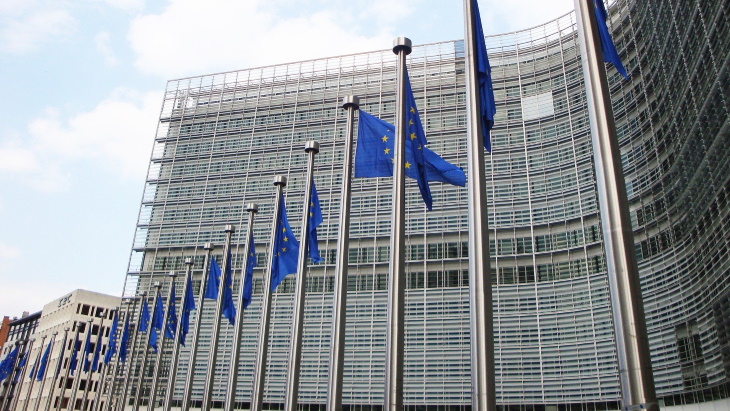 www.world-nuclear-news.org
www.world-nuclear-news.org
Member countries of the European Nuclear Alliance have called upon the next European Commission to recognise the contributions of both nuclear and renewables in Europe's decarbonisation in its upcoming programme, covering the period 2024-2029. The Alliance met on 15 October in Luxembourg in the margins of the Energy Council with ministers and high-level representatives from 14 EU member states (including the upcoming Polish presidency) as well as the European Commission. In a joint statement, the Alliance said: "In a changing global geopolitical context, the upcoming 2024-29 Commission's mandate must ensure the competitiveness and resilience of our economies towards reaching climate-neutrality by 2050 and to address the 'existential challenge' that Europe is facing. "Nuclear energy, alongside renewable energy, is a cost-competitive solution to meet the growing demand for fossil-free electricity and mitigate climate change, thanks to its low-carbon footprint. Nuclear energy is the ready-available fossil-free technology able to produce consistent baseload dispatchable power, ensuring both our collective security of supply and the necessary flexibility in our electricity market." In March, the European Nuclear Alliance outlined four pillars of action to set "an enabling European framework to foster a robust European nuclear industry and guarantee the security of supply of nuclear materials, particularly nuclear fuel, for power and non-power uses". These included: developing access to private and public financing, and exploring the possibilities and benefits of European financing instruments; developing a skilled and diverse nuclear workforce for all civil nuclear applications; scaling-up industrial, research and innovation collaboration across a European value chain through concrete projects; and respecting the national choices of all member states with regards to the decarbonisation of their energy mix to strengthen our unity. "We commit to intensify our cooperation within the Alliance, with all other like-minded EU member states and with the European Commission on these four pillars," the Alliance said in their latest statement. "The benefits of existing and future nuclear power plants go beyond the borders of member states which opt for nuclear energy," they continue. "Indeed, low-carbon baseload energies such as hydro or nuclear power stabilise our common grid and the entire European electricity market. "Nuclear energy as well as renewables are true collective assets for the European Union. Due to its baseload profile and low operating costs, nuclear power production creates less volatile market conditions. Without such energies, there is no path for the EU to provide to its citizens affordable, reliable and abundant low-carbon energy while achieving net-zero by 2025." The 103 nuclear power reactors currently in operation in the EU provide it with about one-quarter of its electricity. The current Commission's term of office runs until 31 October 2024. Between 6 and 9 June, EU citizens voted to elect the 720 members of the next European Parliament. European Commission President Ursula von der Leyen was elected for a second mandate. The European Nuclear Alliance comprises Bulgaria, Croatia, the Czech Republic, Finland, France, Hungary, the Netherlands, Poland, Romania, Slovakia, Slovenia and Sweden, plus Belgium and Italy as observers.
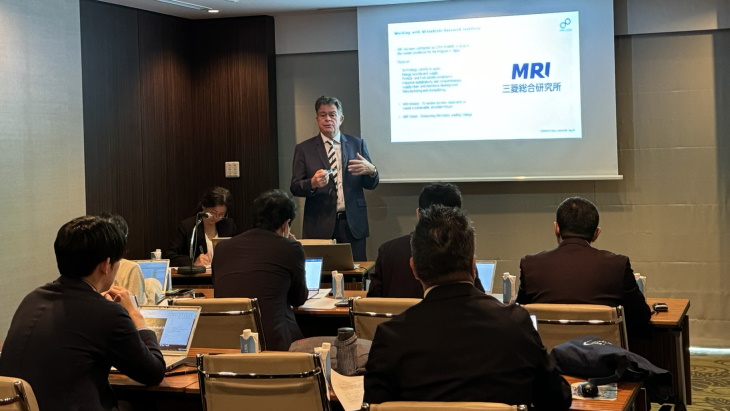 www.world-nuclear-news.org
www.world-nuclear-news.org
Core Power announced it has signed an agreement with Mitsubishi Research Institute to study market conditions for a maritime civil nuclear programme in Japan. The UK-based company is also nearing completion of its Series B funding round of USD500 million. Core Power said it signed the agreement with Mitsubishi Research Institute to "further strengthen its operations". "Japan will play a major role in the development of the specially designed ships as it is a world leader in innovative engineering and shipbuilding," said Core Power CEO Mikal Bøe. "Core Power is also working to build continued support from Japanese, European and American end users in shipping, finance, industry and trading houses." In May last year, it was reported that more than a dozen Japanese companies - including Onomichi Dockyard and Imabari Shipyard - had invested a combined total of about USD80 million in Core Power, which is helping develop a floating molten salt reactor nuclear power plant and other maritime applications. The British company is now reportedly majority-owned by Japanese companies. Core Power said its technology will "power large ocean-going ships with dramatic improvements in energy efficiency and true zero emissions, an estimated USD3 trillion market for large ships by 2060". It also plans to provide reliable, clean floating nuclear energy to coastal customers, on time and on budget. Estimates are that the floating nuclear power market will reach USD2.6 trillion by 2060. Once the first ships and floating power plants are built, Core Power will co-own and operate 'turnkey' floating nuclear power solutions with customer investors. The company said it aims to build an order book of critical mass by 2030 worth up to USD10 billion. "We are entering an exciting period in the development of maritime nuclear technology, as we move from the drawing board to building technology which will change the face of shipping for good," Bøe said. The shipping industry consumes some 350 million tonnes of fossil fuel annually and accounts for about 3% of total worldwide carbon emissions. In July last year, the shipping industry, via the International Maritime Organization, approved new targets for greenhouse gas emission reductions, aiming to reach net-zero emissions by or around 2050.
 www.nucnet.org
www.nucnet.org
Japan’s Nuclear Regulation Authority on Wednesday (16 October) approved the Takahama-1 nuclear power plant to continue operations for the next 10 years, making it the country’s first reactor to be endorsed to operate beyond 50 years. The regulator confirmed owner and operator Kansai Electric Power Company’s assessment that the plant is safe to operate. It also approved Kansai Electric’s plan for ageing countermeasures at the unit over the next 10 years. The 780-MW Takahama-1 pressurised water reactor unit, in Fukui Prefecture, western Japan is the oldest operational nuclear power reactor in the country. It began commercial operation in November 1974. Kansai Electric applied to the NRA in November last year to operate the plant for a further 10 years after conducting an ageing technical evaluation and formulating a long-term facility management policy. The Takahama station has four units, all of which have been restarted since the 2011 Fukushima-Daiichi disaster. Takahama-1 was restarted in July 2023 after being offline since January 2011. Before Fukushima, Japan’s fleet of 54 nuclear plants generated about 30% of the country’s electricity, but were all shut down for safety checks following the accident. Among the 33 operable nuclear reactors in Japan, 12 have now resumed operations after meeting post-Fukushima safety standards. The restarted plants are: Sendai-1 and -2, Genkai-3 and -4, Ikata-3, Mihama-3, Ohi-3 and -4 and Takahama-1, -2, -3 and -4. Earlier this week, Chugoku Electric Power Company said its Shimane-2 nuclear power plant in Shimane Prefecture, southwest Japan, will restart in early December, a move that will bring the number of reactors online to 13 and boost the nation’s power supply this winter. Under regulations which came into force in July 2013, Japanese reactors had a nominal operating period of 40 years. One extension to this – limited to a maximum of 20 years – could be granted, bringing the maximum to 60 years. In December 2022, the NRA approved a new rule that would allow reactors to be operated for more than 60 years. The rule effectively extended the amount of time reactors can remain operational beyond 60 years by excluding time spent on inspections and other periods they are offline from consideration when calculating their total service life. Japan’s cabinet formally adopted the new rule in February 2023.
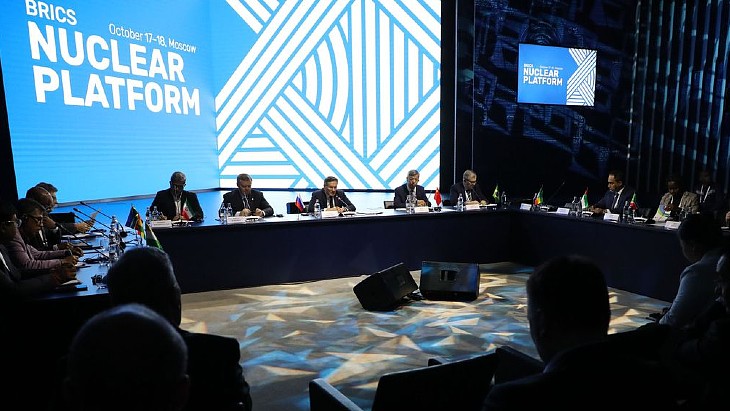 www.world-nuclear-news.org
www.world-nuclear-news.org
The creation of the Nuclear Energy Platform is intended to share experience and support the development of nuclear technologies among BRICS+ member countries. The intergovernmental BRICS organisation's members are currently Brazil, Russia, India, China, South Africa, Iran, Egypt, Ethiopia and the UAE, with more than 20 other countries also expressing an interest in joining the organisation which is widely seen as a counterbalance to the G7 grouping of industrialised nations. The presidency of what is now sometimes referred to as BRICS+ since its expansion from 5 to 10 members this year, is currently held by Russia, with its annual summit taking place in the city of Kazan next week. But ahead of that event, the BRICS+ Business Forum has been taking place, with the issue of collaboration in the field of peaceful uses of nuclear technology discussed at a meeting at Moscow Atom Museum. Alexey Likhachev, Rosatom director general, said that nearly all the organisation's members were implementing projects in the field of nuclear energy: "Today, many BRICS members are the technological drivers of the international nuclear market. The common experience can and should be used and replicated throughout the BRICS space and on the planet as a whole. Therefore, we propose to join forces within the framework of the BRICS nuclear platform, a voluntary alliance of companies, professional nuclear communities and NGOs supporting the development and implementation of nuclear technologies." BRICS member countries currently have 390 GWe of operable nuclear power units with a further 66 MWe under construction. One of the platform's aims is to help companies, if required, with persuading their governments to see nuclear as a clean energy source, and also share assistance for dealing with other issues which may be hampering nuclear energy projects. According to Russia's official Tass news agency, Likhachev told reporters that the process of legal formalisation of the Nuclear Energy Platform had started and that its main aim was to develop and implement best practices relating to energy and non-energy use of nuclear technologies for peaceful purposes in BRICS and BRICS+ markets and to develop incentivising mechanisms and models of projects’ implementation in member countries. It reported him as saying that the platform was intended for companies, nuclear power plants and related organisations - "those capable of contributing to development of the nuclear power sector" - and the plan had been backed unanimously. Orpet Peixoto, deputy chairman of the Brazilian Association for the Development of the Nuclear Industry, said: "I am very happy with the progress in the formation of the Platform. I believe that it will prove fruitful for BRICS countries and BRICS associate member-states ... we are one of the very few countries in the world with all the elements of nuclear fuel cycle but we need support, we need financing, and we know that we can get them through cooperation with the BRICS countries. So, I see Brazil has a lot to gain from the cooperation within the platform." Meanwhile, speaking at the BRICS business forum on Friday, Russian President Vladimir Putin said that BRICS members now had a bigger share of global gross domestic product than the G7 members, saying its members were "in fact the drivers of global economic growth" and with the development of "communication channels, technological and educational standards, financial systems, payment instruments and, of course, mechanisms for sustainable, long-term investment ... the economic growth of BRICS members in the future will increasingly depend less on outside influence or interference".
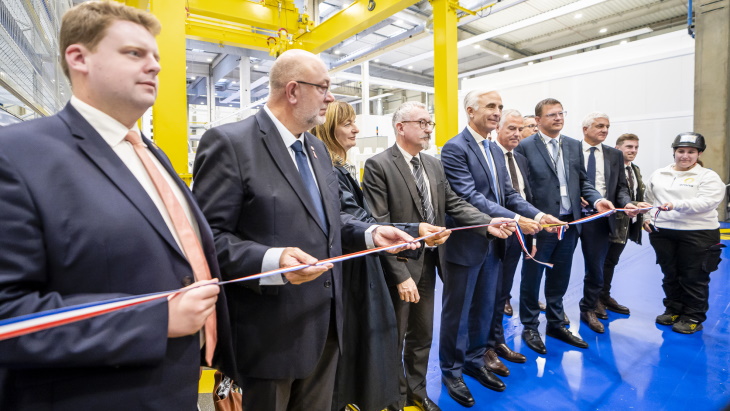 www.world-nuclear-news.org
www.world-nuclear-news.org
Orano has inaugurated a new fully-automated manufacturing plant in the port of Cherbourg, Normandy, for the fabrication of its TN Eagle casks for the transport and dry storage of used nuclear fuel. The opening ceremony was held in the presence of Claude Imauven, chairman of the Orano board of directors and Frédéric de Agostini, senior executive vice president in charge of nuclear packaging and services, together with customers, elected officials and economic stakeholders from the region. Construction of the 6600-square-metre TN Eagle 4.0 factory began in February 2023, with the support of the France Relance investment fund. Equipped with manufacturing processes featuring disruptive technology compared with market standards, the fully-automated factory can assemble weld-free packages in 15 months, compared with an average of more than 40 months for previous-generation products. The TN Eagle factory has a production capacity of up to 30 packages per year. "Implementation of these new processes has been made possible thanks to a design that is innovative in itself," Orano said. "With up to ten times fewer parts than similar packaging, zero welding and exceptional modularity, the TN Eagle design optimises manufacturing while benefiting from greater robustness." The TN Eagle cask design - 5 metres long, 3 metres in diameter, weighing 150 tonnes - was approved by the French Nuclear Safety Authority in 2020 and by the US Nuclear Regulatory Commission in November last year. Orano said it had already received numerous orders for several dozen TN Eagle casks from French and international customers. "I am proud today to inaugurate our TN Eagle factory, the result of the commitment of the Orano teams who, in just six years, have designed new packaging and commissioned a factory featuring breakthrough technology compared with existing standards, while contributing to more reliable, safer and more competitive manufacturing," Agostini said. "I would like to thank our French and international customers for their trust in us." Orano CEO Nicolas Maes added: "This project reflects the group's desire to develop innovative solutions, combining Orano's historical expertise in the field of nuclear packaging and cutting-edge technologies. This new industrial facility, located in the area of Nord-Cotentin, allows us to maximise our support for the needs of our customers all over the world." Orano NPS - a subsidiary of the Orano group - provides global logistics solutions to its customers throughout the world, ranging from the design of packages, together with their approval and manufacture, through to nuclear materials transport operations. Orano NPS carries out more than 6000 transport operations annually worldwide.
 www.nucnet.org
www.nucnet.org
The US has announced initial contracts to four companies hoping to produce high-assay low-enriched uranium, or Haleu, for an expected new generation of high-tech nuclear power reactors, the US Department of Energy (DOE) said on Thursday (17 October). Russia is currently the only country that makes Haleu in commercial volumes. Funds to make the fuel domestically in the US were included in a May 2024 law to ban uranium shipments from Russia by 2028. The four companies awarded contracts are US-based Centrus Energy subsidiary American Centrifuge Operating; Urenco USA, which is a British, Dutch, German company with operations in New Mexico; Orano USA, based in Maryland with global headquarters in France; and a company called General Matter. “All contracts will last for up to 10 years and each awardee receives a minimum contract of $2 million [€1.8m], with up to $2.7 billion available for these services, subject to the availability of appropriations,” the DOE said. Energy secretary Jennifer Granholm said the announcement represents the Biden-Harris administration’s latest efforts to build a secure domestic Haleu supply chain, which is essential to bringing advanced nuclear reactors online and meeting the growing demand for clean, reliable electricity. Haleu is uranium enriched between 5 and 20%, which increases the amount of fissile material to make the fuel more efficient relative to lower-enriched forms of uranium. Many advanced reactors – likely to be deployed from the 2030s onwards – will use Haleu to achieve smaller designs, longer operating cycles, and increased efficiencies over current technologies. Under the DOE contracts, the four companies will bid on future work to produce and store Haleu in the form of uranium hexafluoride gas to eventually be made into fuel for advanced reactors. Centrus president and chief executive officer Amir Vexler said the award could facilitate the potential expansion of Centrus’ first-of-a-kind Haleu production capacity in Piketon, Ohio, to help meet the needs of the advanced nuclear industry and the nation. “It represents a critical piece of the public-private partnership we are working to build so that we can restore a robust, American-owned uranium enrichment capability to power the future of nuclear energy.” Advanced Reactors ‘Key To Clean Energy Future’ The DOE said advanced nuclear reactors are key to the US’s clean energy future and meeting ambitious clean energy and climate goals. “The United States currently lacks commercial Haleu enrichment capabilities to support the deployment of advanced reactors,” it noted. “These contracts support the buildout of a robust Haleu supply chain in the United States and complement last week’s announcement of contracts to support Haleu deconversion services.” That announcement was of six companies chosen as awardees under an $800m DOE contract to provide Haleu deconversion services for advanced nuclear power reactors. The six companies were BWXT, Centrus, Framatome, GE Vernova, Orano and Westinghouse. President Joe Biden’s administration believes nuclear power, which generates virtually emissions-free electricity, is critical in fighting climate change, ensuring energy security and to meet rising power demand from the growing number of data centres and other consumers. Smaller reactors can be used for power generation, but also for district heating, and industrial applications such as oil refining, desalination, and steel production.
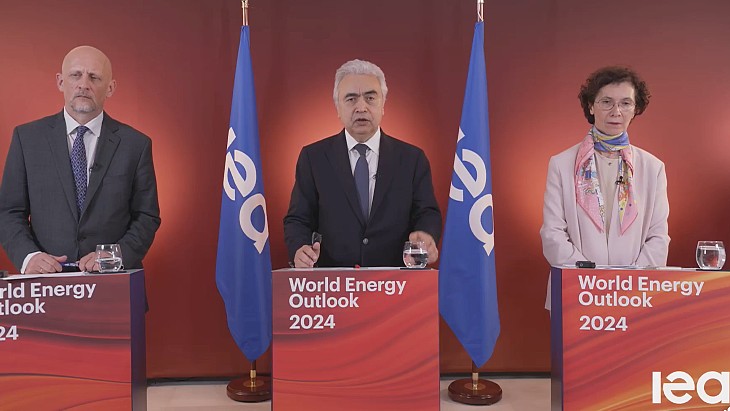 www.world-nuclear-news.org
www.world-nuclear-news.org
Global nuclear generating capacity is expected to increase from 416 GWe in 2023 to 647 GWe in 2050 in a scenario based on existing energy policies, according to the latest World Energy Outlook from the International Energy Agency. "Today's geopolitical tensions and fragmentation are creating major risks both for energy security and for global action on reducing greenhouse gas emissions," according to the IEA. "The world is set to enter a new energy market context in the coming years, marked by continued geopolitical hazards but also by relatively abundant supply of multiple fuels and technologies." IEA Executive Director Fatih Birol said: "In the second half of this decade, the prospect of more ample - or even surplus - supplies of oil and natural gas, depending on how geopolitical tensions evolve, would move us into a very different energy world from the one we have experienced in recent years during the global energy crisis." Based on current policies, the latest report finds that low-emission sources are set to generate more than half of the world's electricity before 2030 – and demand for all three fossil fuels – coal, oil and gas – is still projected to peak by the end of the decade. However, it warns that despite growing momentum behind clean energy transitions, the world is still a long way from a trajectory aligned with its net-zero goals. The World Energy Outlook 2024 considers three scenarios. The Stated Policies Scenario (STEPS) provides an outlook based on the latest policy settings, including energy, climate and related industrial policies. The Announced Pledges Scenario (APS) assumes all national energy and climate targets made by governments are met in full and on time. The Net Zero Emissions by 2050 Scenario (NZE) looks at what must be done to limit global warming to 1.5°C. In the STEPS scenario, clean energy deployment accelerates as the pace of overall energy demand growth slows, leading to a peak in all three fossil fuels before 2030. Increasing reductions in coal demand means it is overtaken by natural gas in the global energy mix by 2030. Clean energy grows more than total energy demand between 2023 and 2035. Led by surging solar photovoltaic (PV) and wind power, clean energy becomes the largest source of energy in the mid-2030s. Although the STEPS scenario sees a threefold increase in renewables that brings fossil fuel use down from 80% of total energy demand in 2023 to 58% in 2050, this falls far short of the step change that occurs in the APS scenario and the NZE scenario, especially the latter. In both these scenarios, renewables begin to rapidly eat into the fossil fuel market share. By 2035, clean energy meets 40% of global energy demand in the APS, and this rises to nearly three-quarters by 2050. In the NZE scenario, clean energy meets 90% of global energy demand in 2050. Around one-third of the remaining fossil fuel demand in the NZE scenario is fully abated, around half is used as a feedstock or in other non-energy use, and the remainder is offset by direct air capture, negative emissions from bioenergy or other forms of carbon removal. Speaking at a press conference to launch the new report, Laura Cozzi, director of sustainability, technology and outlooks at the IEA, said: "We are expecting to see a new record high (in nuclear generating capacity) in 2025 and we expect nuclear to continue to grow as many countries are revising their policies over nuclear, actually extending lifetimes and opening up some new nuclear installations. And this is throughout the world: from China to Europe to the United States and beyond." Nuclear capacity and generation are set to increase in each scenario. Emerging market and developing economies drive this growth, notably China, which accounts for 40% of global nuclear capacity additions in the STEPS scenario by 2035 and almost 50% in the NZE scenario. The IEA noted that these projected additions mean that China is on track to have the largest nuclear power capacity in the world by around 2030 in each scenario. Nuclear generating capacity increases from 416 GWe in 2023 to 647 GWe in 2050 in the STEPS scenario. In this scenario, global nuclear generation increases from 2765 TWh in 2023 to 4460 TWh in 2050, while its share of total electricity production decreases from 9% to 8% over the same period. In the APS scenario, nuclear generating capacity increases to 874 GWe in 2050, while in the NZE scenario it reaches 1017 GWe in 2050. "Policy support for nuclear power has risen in recent years," the IEA noted. "In December 2023, more than 20 countries pledged to triple global nuclear capacity by 2050. Notable developments in several European countries include extending operations for existing reactors in Belgium, lifting a ban on developing new nuclear plants in Switzerland, the identification of new builds as a priority in Sweden and Poland, and confirmation of the importance of nuclear in France. Many countries are showing interest in small modular reactors and the first projects outside China and Russia are expected to come online around 2030." Sama Bilbao y León, director general of World Nuclear Association, said: "The report makes clear nuclear energy will remain an important part of a clean and reliable electricity mix, with more than a doubling of nuclear capacity in the Announced Pledges scenario, and a capacity above 1000 GWe in the Net Zero 2050 scenario. "Our analyses are even more ambitious, predicting nuclear capacity needing to grow to more than 1200 GWe to reach net-zero in a cost-effective and equitable manner. This goal to triple global nuclear capacity by 2050 was announced by 25 countries at COP28 last year, endorsed by the nuclear industry through the Net Zero Nuclear initiative, and supported by 14 major global banks and financial institutions less than a month ago."
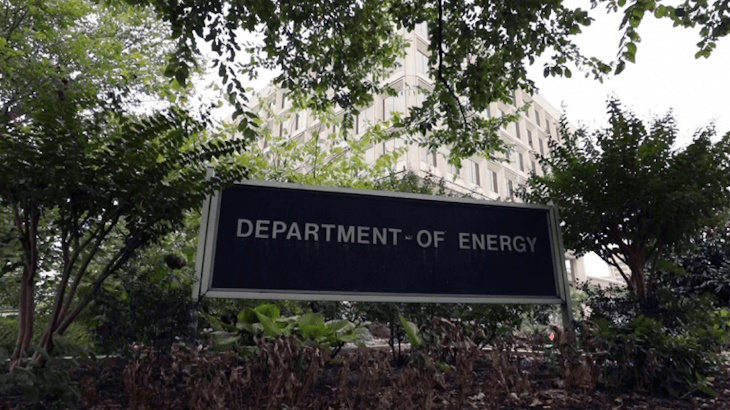 www.world-nuclear-news.org
www.world-nuclear-news.org
The US Department of Energy has opened applications for funding to support the initial domestic deployment of Generation III+ small modular reactor technologies. Up to USD800 million will go to two "first-mover" teams, with USD100 million to address so-called gaps that have hindered plant deployments. The Department of Energy (DOE) estimates the USA will need some 700-900 GWe of additional clean, firm power generation capacity to reach net-zero emissions by 2050, and nuclear power is a proven option that could be deployed to meet this growing demand. As well as looking to operating life extensions, reactor capacity uprates, reversing plans to close reactors, and even restarting formerly closed reactors, utilities are "are earnestly exploring building new reactors to meet the fast-growing demand for carbon-free energy", the agency said. Small modular reactors (SMRs) can be used for multiple applications included power generation, process heat, desalination, and Generation III+ (Gen III+) SMRs "may be able to revitalise and leverage the expertise, workforce, and supply chains supporting the existing fleet of large light-water reactor designs, thus providing a near-term path for new nuclear deployments and operation", it said. According to the solicitation documentation, a Gen III+ SMR is defined as a nuclear fission reactor that uses light water as a coolant and low-enriched uranium fuel, with a single-unit net electrical power output of 50-350 MWe, that maximises factory fabrication approaches, and the same or improved safety, security, and environmental benefits compared with current large nuclear power plant designs. The funding aims to assist the private sector in establishing a "credible and sustainable pathway" to deploying a fleet of Gen III+ SMRs that "advances environmental protection and community benefits, creates new, good-paying, high-quality jobs, and reinforces America’s leadership in the nuclear industry". The funding will be offered in two tiers. Tier 1 - First Mover Team Support - is managed by the DOE Office of Clean Energy Demonstrations and will provide up to USD800 million for milestone-based awards to support up to two first mover teams of utility, reactor vendor, constructor, and end-users/off-takers committed to deploying a first plant while facilitating a multi-reactor, Gen III+ SMR orderbook and working alongside the US National Nuclear Security Administration to incorporate safeguards and security by design into the projects. Teams who wish to apply for Tier 1 funding must include a US utility, reactor technology vendor, and engineering, procurement, and construction (EPC) company. Tier 2 - Fast Follower Deployment Support - is managed by the DOE Office of Nuclear Energy, and will provide up to USD100 million to spur additional Gen III+ SMR deployments by addressing key gaps that have hindered the domestic nuclear industry in areas such as design, licensing, supplier development, and site preparation. "Revitalising America's nuclear sector is key to adding more carbon free energy to the grid and meeting the needs of our growing economy - from AI and data centres to manufacturing and healthcare," Secretary of Energy Jennifer Granholm said. The funding is created by the Consolidated Appropriations Act of 2024 and uses funds from Bipartisan Infrastructure Law. The deadline for applications is 17 January 2025.
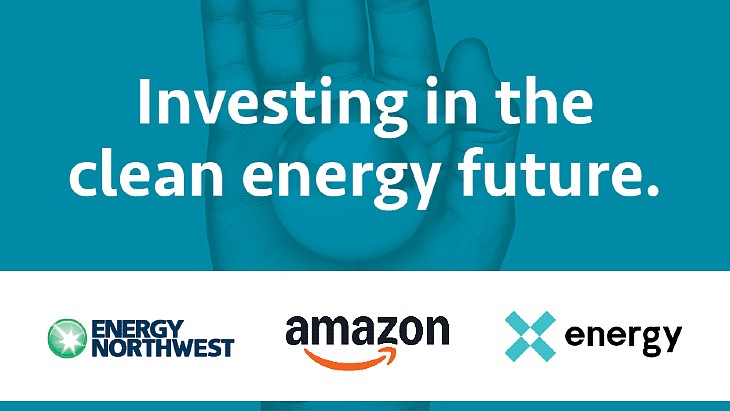 www.world-nuclear-news.org
www.world-nuclear-news.org
Amazon has announced it has taken a stake in advanced nuclear reactor developer X-energy, with the goal of deploying up to 5 GW of its small modular reactors in the USA by 2039. Online shopping and web services giant Amazon's Climate Change Pledge Fund was described as the anchor investor in a USD500 million financing round for X-energy, alongside Ken Griffin, founder and CEO of Citadel, Ares Management Corporation, private equity firm NGP and University of Michigan. The funding is designed to pave the way to completion of the reactor design and licensing, and the first phase of its TRISO-X fuel fabrication facility at Oak Ridge, Tennessee. The first project The first project looks set to be in Washington State, with Amazon announcing it had signed an agreement with Energy Northwest, a consortium of state public utilities, for an initial four advanced small modular reactors (SMRs) generating about 320 MWe, with an option to treble that number, which would be able to power 770,000 homes. Amazon will fund the initial feasibility phase for the SMR project which is planned for a site near the energy company's Columbia Generating Station nuclear energy facility in Richland. Under the agreement Amazon would have the right to purchase electricity from the first phase, while Energy Northwest will have the option to build the eight extra modules, with the additional power being available to Amazon and utilities in the area. Matt Garman, CEO of Amazon Web Services, said: "One of the fastest ways to address climate change is by transitioning our society to carbon-free energy sources, and nuclear energy is both carbon-free and able to scale - which is why it’s an important area of investment for Amazon. Our agreements will encourage the construction of new nuclear technologies that will generate energy for decades to come." Greg Cullen, Vice President for Energy Services & Development at Energy Northwest, said: "We've been working for years to develop this project at the urging of our members, and have found that taking this first, bold step is difficult for utilities, especially those that provide electricity to ratepayers at the cost of production. We applaud Amazon for being willing to use their financial strength, need for power and know-how to lead the way to a reliable, carbon-free power future for the region." The advanced reactors The Xe-100 is a Generation IV advanced reactor design which X-energy says is based on decades of high temperature gas-cooled reactor operation, research, and development. Designed to operate as a standard 320 MWe four-pack power plant or scaled in units of 80 MWe. At 200 MWt of 565°C steam, the Xe-100 is also suitable for other power applications including mining and heavy industry. The Xe-100 uses tri-structural isotropic (TRISO) particle fuel, which has additional safety benefits because it can withstand very high temperatures without melting, X-energy says its design makes it road-shippable with accelerated construction timelines and more predictable and manageable construction costs, and is well suited to meet the requirements of energy-intensive data centres. Clay Sell, X-energy CEO, said: "Amazon and X-energy are poised to define the future of advanced nuclear energy in the commercial marketplace. To fully realise the opportunities available through artificial intelligence, we must bring clean, safe, and reliable electrons onto the grid with proven technologies that can scale and grow with demand. We deeply appreciate our earliest funders and collaborators, notably the US Department of Energy and Dow Inc. With Amazon, Ken Griffin, and our other strategic investors, we are now uniquely suited to deliver on this transformative vision for the future of energy and tech." The initial Xe-100 plant is being developed at Dow Inc's UCC Seadrift Operations site on the Texas Gulf Coast, which would be the first nuclear reactor deployed to serve an industrial site in the USA. What else has been announced? A memorandum of understanding has also been signed with utility company Dominion Energy to look into the development of an SMR project near the company's existing North Anna nuclear power station. It is not the first move into nuclear energy from Amazon, which is co-locating a data centre facility next to Talen Energy's nuclear power plant in Pennsylvania. Robert Blue, Chairman and CEO of Dominion Energy, said: "This agreement builds on our longstanding partnership with Amazon and other leading tech companies to accelerate the development of carbon-free power generation in Virginia. It's an important step forward in serving our customers' growing needs with reliable, affordable and increasingly clean energy. This collaboration gives us a potential path to advance SMRs with minimal rate impacts for our residential customers and substantially reduced development risk." In July, Dominion Energy announced a Request for Proposals from leading SMR nuclear technology companies to evaluate the feasibility of developing an SMR at the company's North Anna plant - while it is not a commitment to build an SMR, it is an important first step in evaluating the technology and the feasibility of developing it at North Anna the company says. Data centres and nuclear Amazon's series of announcements confirms a recent trend of data centre operators looking at nuclear energy as a way to get reliable energy that is carbon free. Amazon noted that it is not just their data centres and web services which are going to see increasing electricity demand, but also wider developments such as electrifying its vehicle fleet. On Tuesday, a fellow online giant, Google, signed a Master Plant Development Agreement with Kairos Power for the development and construction of a series of advanced reactor plants. And last month Microsoft announced it had signed a 20-year power purchase agreement with Constellation which would see Three Mile Island unit 1 restarted, five years after it was shut down.
 www.nucnet.org
www.nucnet.org
Nuclear is one of seven clean energy technologies that are key to affordable and secure transitions, but overcoming barriers to deployment, including network infrastructure, should be a priority worldwide. Together the seven technologies – nuclear, solar PV, wind, electric vehicles, heat pumps, hydrogen and carbon capture – could account for three-quarters of tCO2 emissions reductions to 2050, complemented by other renewables such as bioenergy and geothermal, and energy efficiency. According to the International Energy Agency’s latest World Energy Outlook, published on 16 October, the share of nuclear power is likely to remain close to 10% under three main long-term scenarios. The IEA, a Paris-based intergovernmental energy watchdog, said the report comes against a backdrop of escalating risks in the Middle East, Russia’s war in Ukraine and heightened geopolitical tensions globally. It explores a range of energy security issues that decision makers face as they proceed with clean energy transitions. “Regional conflicts and geopolitical strains are highlighting significant fragilities in today’s global energy system, making clear the need for stronger policies and greater investments to accelerate and expand the transition to cleaner and more secure technologies,” the report says. Some of the immediate effects of the global energy crisis had started to recede in 2023, the report says, but the risk of further disruptions is now “very high”. Fatih Birol, the IEA’s executive director, said the report confirms its prediction that the world’s fossil fuel consumption will peak before 2030 and fall into permanent decline as climate policies take effect. But continuing investment in fossil fuel projects will spell falling market prices for oil and gas, the IEA added. Surge In Clean Energy Demand To Continue The IEA has predicted that the surge in demand for clean electricity sources will accelerate further in the years ahead, adding the equivalent of Japan’s power demand to the world’s total electricity use each year in a scenario based on today’s policy settings. The report’s projections based on today’s policy settings indicate that the world is set to enter a new energy market context in the coming years, marked by continued geopolitical hazards but also by relatively abundant supply of multiple fuels and technologies. In last year’s World Energy Outlook the IEA said a changing policy landscape was creating opportunities for a nuclear comeback with global reactor capacity potentially reaching well over 900 GW by 2050, more than double the 417 GW in 2022. In July the IEA said global nuclear generation is on track to reach a new high in 2025, surpassing its previous record in 2021. According to the agency, nuclear generation is forecast to rise globally by 1.6% in 2024, and by 3.5% in 2025.
 www.nucnet.org
www.nucnet.org
Google will back the construction of seven small modular nuclear reactors (SMRs) from Kairos Power, becoming the first tech company to commission new nuclear power plants to provide low-carbon electricity for its energy-hungry data centres. Google and Kairos said on Monday (14 October) that under the terms of the deal, the first of its kind, Google committed to buying power generated by seven reactors to be built by Kairos Power, a seven-year-old California-based startup. The agreement targets adding 500 MW of nuclear power starting at the end of the decade, the companies said. The first reactor could be online by 2030 and additional reactors by 2035. Google said that buying power from multiple SMRs sends an “important demand signal to the market”, while making a long-term investment to accelerate commercialisation. “We believe that nuclear energy has a critical role to play in supporting our clean growth and helping to deliver on the progress of AI,” said Michael Terrell, senior director for energy and climate at Google. “The grid needs these kinds of clean, reliable sources of energy that can support the build out of these technologies... We feel like nuclear can play an important role in helping to meet our demand, and helping meet our demand cleanly, in a way that’s more around the clock. “The end goal here is 24/7, carbon-free energy,” said Terrell. “We feel like in order to meet goals around round-the-clock clean energy, you’re going to need to have technologies that complement wind and solar and lithium-ion storage.” The company did not disclose the financial terms of the deal. The 500 MW of generation that would be built by Kairos for Google is about enough to power a midsize city – or one AI data centre campus. The project site – or whether there could be reactors at multiple locations –has not been determined, the companies said. Google would have data centres somewhere in the region near the Kairos reactors, but it has not been determined whether they would receive power directly from the nuclear plants or from the grid. Google could count the addition of nuclear power toward meeting its carbon-reduction commitments. The units for Google will include a single 50-MW reactor, with three subsequent power plants that would each have two 75-MW reactors, Kairos said. That compares with about 1,000 MW at reactors at conventional nuclear power plants. Background: Work Has Begun On Demonstration Unit Kairos will have to navigate complex approvals through the US Nuclear Regulatory Commission (NRC), but already has clearance to build a demonstration reactor in Tennessee, which could start operating in 2027. The Hermes Low-Power Demonstration Reactor, which could be operational in 2027, is the first and only Generation IV* reactor to be approved for construction by the NRC and the first non-light-water reactor to be permitted in the US in over 50 years. Hermes is a non-power version of Kairos Power’s fluoride salt-cooled high temperature reactor, the KP-HFR. Kairos has also begun construction on a new reactor-grade salt production facility at its manufacturing development campus in Albuquerque, New Mexico. Mike Laufer, chief executive and co-founder at Kairos, said the demonstration project and the Albuquerque plant are helping the company avoid spiraling costs, a pitfall of the conventional nuclear industry. Tech companies are increasingly interested in nuclear as a medium-term solution to providing low-carbon electricity to meet their data centres’ energy demands. Last month, Microsoft announced that it would commit to buying 20 years’ supply of electricity from the mothballed US nuclear power plant Three Mile Island if Constellation Energy restarted the site. In March, Amazon Web Services, a subsidiary of the online retail giant founded by Jeff Bezos, acquired US power producer Talen Energy’s Cumulus data centre campus at the Susquehanna nuclear power station in Pennsylvania. US computer technology company Oracle wants to power a new data centre through nuclear energy, according to the firm’s chief technology officer Larry Ellison. Speaking during a recent earnings call, Ellison confirmed the cloud computing giant has “already got building permits” for three SMRs, without giving details. Kairos Power: The Reactor Technology Kairos Power’s technology uses a molten-salt cooling system, combined with a ceramic, pebble-type fuel, to efficiently transport heat to a steam turbine to generate power. This passively safe system allows the reactor to operate at low pressure, enabling a simpler more affordable nuclear reactor design. Instead of water, which is used in traditional reactors, Kairos uses molten fluoride salt as a coolant. The molten salts transfer heat away from the reactor core. The heat can then be used either to produce electricity or for industrial processes such as oil refining, desalination, and steel production. These reactors have several inherent safety advantages. The first, and possibly the most important, is that the reactor is operated at low pressure because the coolants never approach boiling point. Even in an accident, there would be no force expelling materials from the reactor, and no high-pressure containment system would be required to prevent such a release. The plant will use Triso coated particle fuel. Triso – or “tristructural-isotropic” – fuel particles contain a spherical kernel of enriched uranium oxycarbide surrounded by layers of carbon and silicon carbide, which contains fission products. According to the US Department of Energy, Triso is essentially a “robust, microencapsulated fuel form” developed originally in the 1950s. Perhaps Triso’s biggest benefit is that each particle acts “as its own containment system thanks to its triple-coated layers,” the DOE said. This allows them to retain fission products under all reactor conditions. * No precise definition of a Generation IV reactor exists, but the term is used to refer to nuclear reactor technologies under development including gas-cooled fast reactors, lead-cooled fast reactors, molten salt reactors, sodium-cooled fast reactors, supercritical-water-cooled reactors and very high-temperature reactors. An international task force, the Generation IV International Forum (GIF), is sharing R&D to develop six Generation IV nuclear reactor technologies. GIF said goals of Generation IV reactor design include lower cost and financial risk, minimising nuclear waste and high levels of safety and reliability.
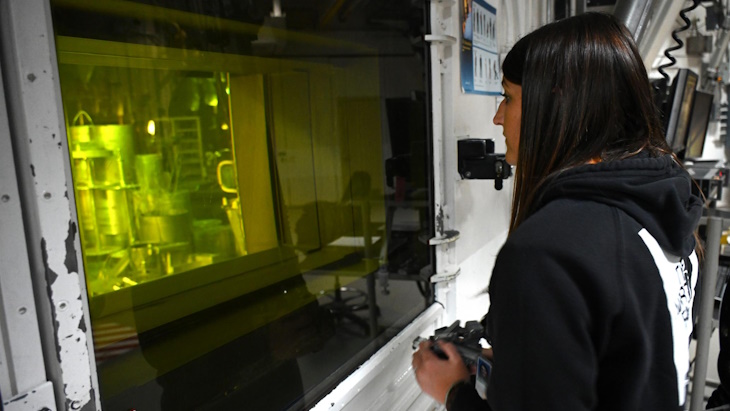 www.world-nuclear-news.org
www.world-nuclear-news.org
The US Department of Energy has approved the Conceptual Safety Design Report for Oklo Inc's Aurora Fuel Fabrication Facility at Idaho National Laboratory. The facility will fabricate fuel for the Aurora "powerhouse" liquid metal-cooled fast reactor plant which is to be located at the same site. The fuel will be fabricated using high assay low enriched uranium (HALEU) recovered from used fuel from the Department of Energy (DOE) Experimental Breeder Reactor-II (EBR-II), which operated at Idaho National Laboratory from 1964 to 1994. Oklo has been granted access to 5 tonnes of HALEU as part of a cooperative agreement with the laboratory that was competitively awarded in 2019. The DOE will retain ownership of the HALEU both during and after its use. California-based Oklo has a site use permit from the DOE to build and operate a prototype of its Aurora reactor at Idaho National Laboratory (INL). In September, it finalised a Memorandum of Agreement with the US DOE Idaho Operations Office granting access to conduct site investigations at its preferred location, and anticipates deploying the first commercial Aurora powerhouse in 2027. The company has also received previous DOE support to advance the Aurora powerhouse design through the Office of Nuclear Energy's Gateway for Accelerated Innovation in Nuclear programme and additional funding to demonstrate recycling technologies through the Advanced Research Projects Agency-Energy (ARPA-E) initiative. "We are proud of our collaboration with INL and DOE as we move closer to turning on our first commercial plant that uses this recovered nuclear fuel in just a few years," said Oklo co-founder and CEO Jacob DeWitte said. Jess Gehin, INL’s associate laboratory director for Nuclear Science and Technology, said the approval of the Conceptual Safety Design Report is a critical step toward fabricating fuel for the first commercial deployment of Oklo's plant: "As the nation’s nuclear energy research laboratory, we are committed to partnering with companies like Oklo to advance fission technologies and deliver clean energy solutions," she added. The Aurora powerhouse is a fast neutron reactor that uses heat pipes to transport heat from the reactor core to a supercritical carbon dioxide power conversion system to generate electricity. It uses metallic fuel to produce about 15 MWe as well as producing usable heat, and can operate on fuel made from fresh HALEU or used nuclear fuel. Earlier this year, Oklo successfully completed the first end-to-end demonstration of the key stages of its advanced fuel recycling process, in collaboration with Argonne National Laboratory and Idaho National Laboratory.
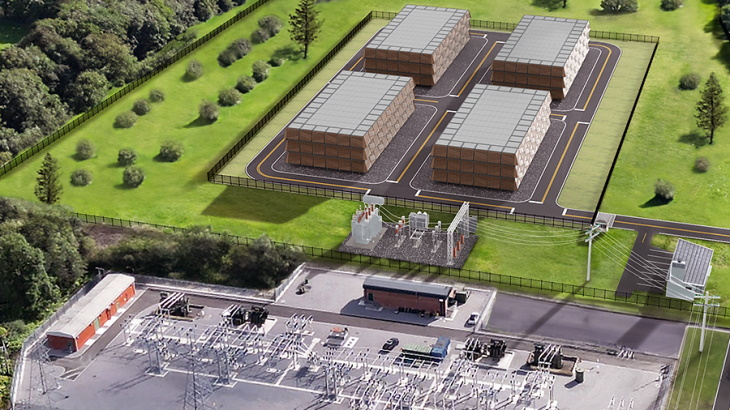 www.world-nuclear-news.org
www.world-nuclear-news.org
US microreactor developer Last Energy has announced plans for four microreactor power plants at the site of the decommissioned Llynfi coal-fired power station in Bridgend County, south Wales. Last Energy is a spin-off of the Energy Impact Center, a research institute devoted to accelerating the clean energy transition through innovation. Its reactor technology is based on a pressurised water reactor with a capacity of 20 MWe or 80 MWt. Power plant modules would be built off-site and assembled in modules. A Last Energy plant, referred to as the PWR-20, is comprised of a few dozen modules that, it says, "snap together like a Lego kit". The PWR-20 is designed to be fabricated, transported, and assembled within 24 months, and is sized to serve private industrial customers. Under its development model, Last Energy owns and operates its plug-and-play power plant on the customer's site, bypassing the decade-long development timelines of electric transmission grid upgrade requirements. The company said it is advancing plans to develop four PWR-20 plants on the vacant site of the Llynfi coal-fired power station. It said the new plants will "provide energy security to local manufacturers, create jobs, and unleash a long-term economic investment in the region". The Llynfi power station - a 120 MW coal plant - operated between 1951 and 1977. Following decommissioning in 1977, the 14-acre site has remained vacant. "We chose Llynfi because of its proximity to a large existing industrial base, which is in need of secure 24/7 clean power," Last Energy said. "Llynfi Clean Energy Project will support growth, revitalisation, and decarbonisation of local industry." Last Energy said it has been actively engaging with the UK's Office for Nuclear Regulation, Natural Resources Wales, Planning and Environment Decisions Wales, the Environmental Agency, and with local and national Welsh and UK officials, and will continue to do so throughout the project. The company is targeting 2027 to commission the first plant, "following a successful planning and licensing process". Last Energy estimates the project represents a capital investment of GBP300 million (USD393 million), which will not require public funding. Contracts with local suppliers would amount to over GBP30 million, while more than 100 full-time local jobs would also be created. "Last Energy's Llynfi project will not only transform a vacant coal site into a hub for clean energy production, it will also create economic opportunity for companies throughout south Wales," Last Energy UK CEO Michael Jenner was quoted as saying by Nation-Cymru. "The benefits of nuclear power speak for themselves, so our focus must be on delivering those benefits on time and on budget. "Last Energy's emphasis on mass-manufacturability allows us to deliver significantly smaller plants in under 24 months with purely private financing. We look forward to engaging with the public, meeting local suppliers, and being an active partner in south Wales' path towards energy security and industrial decarbonisation." In August, the company announced that it had reached commercial agreements for 80 units. Last Energy announced agreements for 34 units in 2023 and began 2024 with agreements for 50 units. Of the agreements, 39 of the 80 units are slated to be built to serve data centre developers. The company says its goal is to build 10,000 units in the next 15 years.
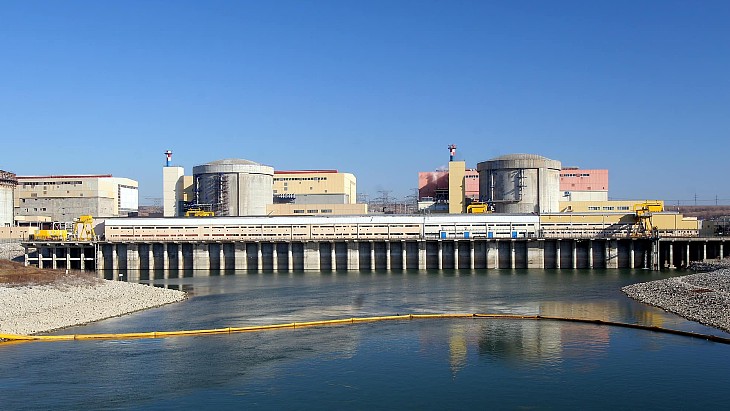 www.world-nuclear-news.org
www.world-nuclear-news.org
Romania's nuclear power plant operator Nuclearelectrica and France's Framatome are aiming to launch a full-scale commercial irradiation service for medical isotopes in 2028. Following the conclusion of a feasibility study, the two companies are now implementing the project, covering detailed engineering procurement, installation and the commissioning of the irradiation system at unit 2 of the Cernavoda nuclear power plant in Romania. Lutetium-177 (Lu-177) is a beta-emitting radioisotope used in targeted radionuclide therapy for the treatment of prostate and other cancers, destroying the cancer cells while leaving healthy cells unaffected. Framatome Healthcare, through its Isogen joint venture with Canada's Kinectrics, is involved in a pioneering international collaboration with Bruce Power and ITM Isotope Technologies Munich SE, to produce Lu-177 from a commercial nuclear power reactor, at Bruce Power's unit 7, which, like Cernavoda, is a Candu pressurised heavy water reactor. The feasibility study concluded that Framatome's technology could be adapted to Cernavoda unit 2 which would be "able to irradiate ytterbium-176 at the market technical standard required to produce lutetium-based radiopharmaceuticals". François Gauché, VP Framatome Healthcare, said: "We are proud to have reached this milestone with Nuclearelectrica and to take this important project on to the next phase. Bringing additional capacities from nuclear power reactors helps build a large-scale, reliable and diversified supply of critical radioisotopes to fight cancer. The demand for massively accessible cutting-edge cancer treatments globally is growing rapidly. The nuclear industry stands ready to play its part in strengthening the supply chain for lifesaving radioisotopes in Europe and across the world." Cosmin Ghita, CEO of Nuclearelectrica, said: "Nuclearelectrica is committed to advancing not only energy production but also public health. The production of lutetium-177 marks a significant milestone for Romania and the global nuclear industry. Our role in supporting cutting-edge oncological treatments through nuclear medicine solidifies the role of nuclear energy in enhancing human well-being. This project highlights the multifaceted contributions that nuclear power can make - clean energy generation and life-saving medical isotopes." Cernavoda 2 is a 650 MWe Candu 6 pressurised heavy water reactor - by the Danube River, 160 kilometres east of the capital Bucharest - which began commercial operation in 2007.
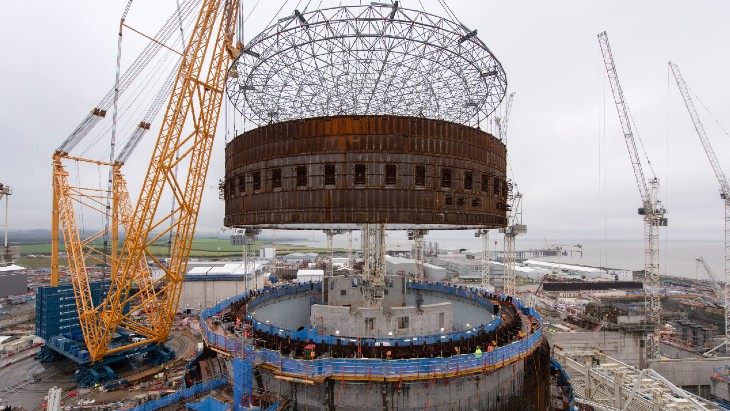 www.world-nuclear-news.org
www.world-nuclear-news.org
The third and top steel ring for Hinkley Point C unit 2's containment building has been lifted into place. Click the original link for the photos.
 www.nucnet.org
www.nucnet.org
The European Industrial Alliance on Small Modular Reactors (SMRs) has identified nine SMR projects it will support as its first batch of project working groups (PWGs). The alliance said the effort marks a significant first step toward Europe’s goal of deploying SMR technologies across the bloc by the early 2030s. The alliance, a collaborative public-private platform launched by the European Commission in February 2024, said on 11 October it picked its first batch of PWGs from a pool of 22 applications submitted as part of a June 2024 call for projects. The nine projects identified at this stage are: EU-SMR-LFR project (Ansaldo Nucleare, SCK-CEN, ENEA, Raten); CityHeat project (Calogena, Steady Energy); Project Quantum (Last Energy); European LFR AS Project (Newcleo); Nuward (EDF); European BWRX-300 SMR (OSGE); Rolls-Royce SMR (Rolls-Royce SMR Ltd); NuScale Voygr SMR (RoPower Nuclear S.A); and Thorizon One project (Thorizon). The selections do not mean the projects gets direct funding from the alliance. However, there will be the opportunity for collaboration among stakeholders including SMR developers, regulators and supply chain companies. Projects that were not selected in this round will have the opportunity to reapply in the second quarter of 2025 after refining their proposals, the alliance said. Projects in the first batch include a range of reactor designs, from lead-cooled fast reactors and pressurised water reactors to molten salt reactors and micro-modular plants. They include plants for power generation, district heating, and industrial applications such as oil refining, desalination, and steel production. In May the alliance held its inaugural meeting in Brussels with the commission saying a new generation of nuclear plants is expected to help the bloc respond to the upcoming high demand for clean electricity and high quantities of hydrogen. The commission said key tasks for the alliance include identifying the most promising and cost-effective SMR technologies eligible for alliance support, strengthening the European supply chain, identifying investment barriers and analysing funding opportunities.
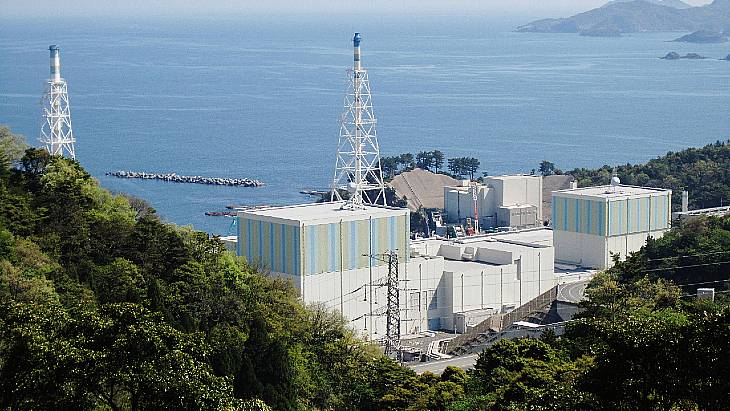 www.world-nuclear-news.org
www.world-nuclear-news.org
Chugoku Electric Power Company plans to restart unit 2 of its Shimane nuclear power plant - which has been offline since January 2012 - in December. It will become the first boiling water reactor (BWR) in Japan to be restarted. Revised regulations were announced by Japan's Nuclear Regulation Authority (NRA) in July 2013, which must be met before reactors can receive permission to restart. These set out requirements for plants to be able to respond to a variety of natural phenomena as well as establish new measures to mitigate the effects of severe accidents, such as reactor core damage caused by beyond design basis events. Chugoku applied to the NRA in December 2013 for inspections to verify whether measures taken at Shimane unit 2 - which has been offline since 27 January 2012 - meet the new safety standards. Chugoku has constructed a 15-metre-high sea wall to protect the plant from tsunamis and made preparations for a potential eruption of the Mount Sanbe volcano. It originally aimed to complete seismic reinforcement and other works for Shimane 2 by the end of February 2023. In June 2021, the NRA approved a draft report finding that Shimane 2 meets the revised regulatory standards. The assessment of the unit was officially adopted in September 2021 after a public comment period and other procedures, clearing the way for it to resume operation, pending local consent. Shimane 2 became the 17th Japanese reactor to pass the regulator's safety screenings and the fifth BWR - the same type as those at the Fukushima Daiichi plant - to receive regulatory approval to restart. Following approvals by the cities of Matsue, Izumo, Yasugi and Unnan, in June 2022 the governor of Shimane prefecture approved the restart of Shimane 2. His approval marked the completion of the process to gain the consent of local communities for the 789 MWe BWR to resume operation. Shimane 2 had been scheduled to restart in August, but Chugoku pushed back the restart due to required safety upgrade work. The utility has now released a revised schedule for the restart of the unit. It plans to begin loading fuel into the reactor's core on 28 October, with the unit expected to restart in early December. Power generation is scheduled to begin in late December, with the reactor resuming commercial operation in January 2025. "We will continue to take all possible measures to ensure the operator's pre-operational inspections proceed steadily with safety as our first priority as well as to respond appropriately to the pre-operational confirmation conducted by the NRA, and we will prepare each and every step toward the restart," Chugoku said. So far, eleven reactors have resumed operation in Japan, all of which have been pressurised water reactors. Shimane unit 1 - a 460 MWe BWR that started commercial operation in March 1974 - is currently being decommissioned. In August 2018, Chugoku initiated the regulatory process for starting up Shimane 3, a new 1373 MWe advanced boiling water reactor nearing completion.
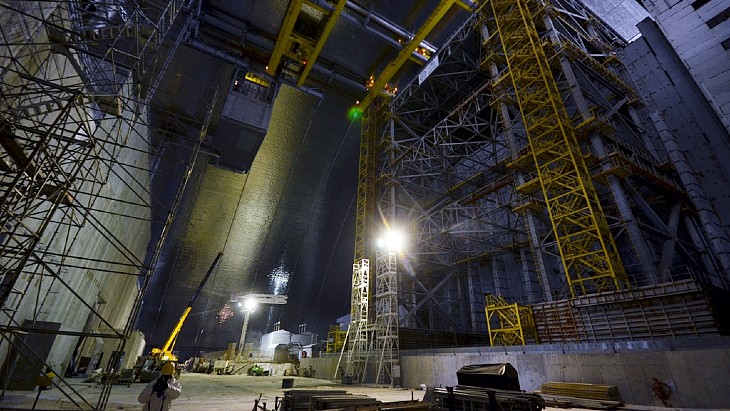 www.world-nuclear-news.org
www.world-nuclear-news.org
The next phase of the project has begun to study which parts of the shelter built rapidly around Chernobyl's unit 4 after the 1986 accident need immediate dismantling and which bits need stabilisation. The project, funded through the International Chernobyl Cooperation Account, aims to determine the scope of early deconstruction work for unstable Shelter structures and provide an initial cost estimate and enable the beginning of design work for the next stage, which includes the dismantling of the unstable Shelter structures. The original shelter over the destroyed unit 4 at Chernobyl was constructed in a matter of just months, and the international Shelter Implementation Plan in the 1990s had three phases - firstly to stabilise it and secondly to build a larger secure construction to enclose it - the New Safe Confinement which was completed in 2017 to pave the way for the dismantling and decommissioning stage. The Shelter Object - also known as the 'sarcophagus' - still contains the molten core of the reactor and an estimated 200 tonnes of highly radioactive material. The stability of the structure has developed into one of the major risk factors at the site. A project to shore up the structure was completed in mid-2008, but at that time the maximum life of the stabilised structures was determined as the end of 2023. The licence for the storage of radioactive waste within the shelter was extended last year from 2023 to 2029, with a 2025 deadline for the development of a new design for the dismantling of "unstable structures with an unacceptably high probability of collapse", and a 31 October 2029 deadline for completion of the dismantling. According to World Nuclear Association, the hermetically-sealed New Safe Confinement allows "engineers to remotely dismantle the 1986 structure that has shielded the remains of the reactor from the weather since the weeks after the accident. It will enable the eventual removal of the fuel-containing materials in the bottom of the reactor building and accommodate their characterisation, compaction, and packing for disposal. This task represents the most important step in eliminating nuclear hazard at the site - and the real start of dismantling". The New Safe Confinement (NSC) is the largest moveable land-based structure built - with a span of 257 metres, a length of 162 metres, a height of 108 metres and a total weight of 36,000 tonnes equipped - and with a lifetime of 100 years, it has been designed to allow for the eventual dismantling of the ageing makeshift shelter from 1986 and the management of radioactive waste. It has also been designed to withstand temperatures ranging from -43°C to +45°C, a class-three tornado, and an earthquake with a magnitude of 6 on the Richter scale. The International Chernobyl Cooperation Account was established in November 2020 by the European Bank for Reconstruction and Development at the Ukrainian government's request to support a comprehensive plan for Chernobyl. UTEM-Engineering LLC has been selected as the consultant. The work also includes "revising the criteria and requirements for the NSC infrastructure to support the dismantling of unstable structures in the Shelter. This also involves developing all necessary technical specifications, including for lifting equipment, systems for processing contaminated dismantled structures, their further transportation, engineering and control systems for" the second stage of the project and "additional radiation monitoring equipment, radiation-protected personnel transfer boxes, and other related documentation".
 www.nucnet.org
www.nucnet.org
The Canadian Nuclear Safety Commission (CNSC) has approved Ontario Power Generation’s (OPG) request to continue operating Pickering units 5 to 8 to the end of 2026, ensuring the units can continue in operation until they are taken offline for refurbishment. In its decision, released on 11 October, the CNSC approved OPG’s request for a licence amendment to operate Units 5 to 8 to 31 December 2026, up to a maximum of 305,000 equivalent full power hours. OPG is planning to refurbish units 5, 6, 7 and 8 at Pickering, marking a major turnaround for the facility, which was scheduled to close by 2025. Pickering currently has six Candu 500 515-MW pressurised heavy water reactor units in commercial operation – Units 1, 4, 5, 6, 7, and 8. Units 2 and 3 were permanently shut down in 2007 and 2008. Units 1 and 4, which began commercial operation in 1973, are set for a permanent retirement at the end of 2024. OPG said it is continuing to advance planning for the refurbishment, which will be complete by the mid-2030s and could see the units operate for another 30 years or more. OPG had intended to begin the refurbishment project this year with engineering and design work and securing long-lead components. OPG’s timeline envisages putting the entire station layup in 2026 so that refurbishment can begin. According to Ontario energy minister Todd Smith, the project will begin with CAD2bn ($1.4bn, €1.3bn) of funding for scoping engineering design work that is expected to begin “over the next year or so.” He suggested that the scoping and engineering work is expected to inform OPG’s future steps, including a firm schedule and accurate cost estimates.
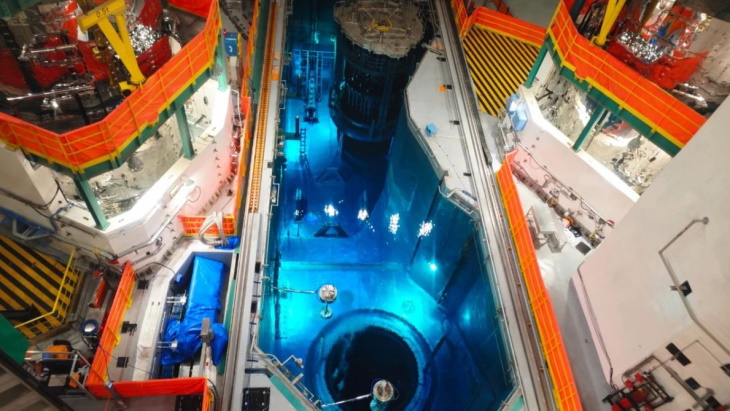 www.world-nuclear-news.org
www.world-nuclear-news.org
The process of loading 177 fuel assemblies into the core of unit 1 of the Zhangzhou nuclear power plant in China's Fujian province has begun ahead of its start-up. The unit is the first of four Hualong One (HPR1000) reactors under construction at the site. China's Ministry of Ecology and Environment issued an operating licence for the unit on 12 October. "At 3.18pm, the Zhangzhou Nuclear Power Unit 1 began to load the first nuclear fuel, marking the entry of the unit into the main system with nuclear commissioning stage, laying a solid foundation for the subsequent unit criticality, grid-connected power generation and other work," China National Nuclear Corporation (CNNC) said. In May 2014, the local government gave approval for Phase I of the Zhangzhou plant, comprising two AP1000 units. The National Nuclear Safety Administration gave approval in December 2015 for the AP1000 units and confirmed site selection in October 2016. Construction of Phase I had originally been expected to start in May 2017. However, CNNC subsequently decided to use the HPR1000 (Hualong One) design instead. Two more Hualong One units are planned for Phase II of the plant and a further two proposed for Phase III. Construction of Zhangzhou 1 began in October 2019, with that of unit 2 starting in September 2020. In September 2022, China's State Council approved the construction of two further Hualong One units as Phase II of the Zhangzhou plant. First concrete for the nuclear island of unit 3 was poured on 22 February this year. First concrete for unit 4 was poured last month. The Zhangzhou project - with a total investment of over CNY100 billion (USD14 billion) - is owned by CNNC-Guodian Zhangzhou Energy Company, a joint venture between CNNC (51%) and China Guodian Corporation (49%). "After completion, it will inject strong impetus into the economic and social development of Fujian Province," CNNC said.
 www.nucnet.org
www.nucnet.org
Westinghouse Electric Company and shipbuilding company Seaspan have signed a memorandum of understanding to support nuclear new-build projects in Canada and around the world. Under the agreement, North Vancouver-based Seaspan has the potential to manufacture key reactor components for Westinghouse’s AP1000 and AP300 nuclear power plants, including pipe spools and steel structures. With three shipyards in British Columbia and a workforce of 4,000 employees, Seaspan is a leader in shipbuilding, maintenance, and ship repair with experience in delivering complex manufacturing projects. Westinghouse said this aligns well with the requirements of large-scale capital projects such as AP1000 and AP300 reactors. Westinghouse said the agreement strengthens its commitment to Canada’s economy and further develops the nation’s nuclear supply chain to support Westinghouse’s global fleet of advanced reactors. The company said that for each AP1000 unit that is built outside Canada, it could generate almost CAD1bn ($730m, €660m) in gross domestic product through local suppliers. Westinghouse said it continues to work closely with Canadian suppliers on components for its AP1000 reactor, the only Generation III+ reactor currently in operation. Six AP1000 reactors are operating globally, with eight more under construction. The company is also collaborating with the Canadian supply chain for its AP300 small modular reactor, a 300-MW single-loop plant based on AP1000 technology, and the eVinci microreactor, which can provide up to 5 MW of electricity for eight-plus years for a variety of applications.
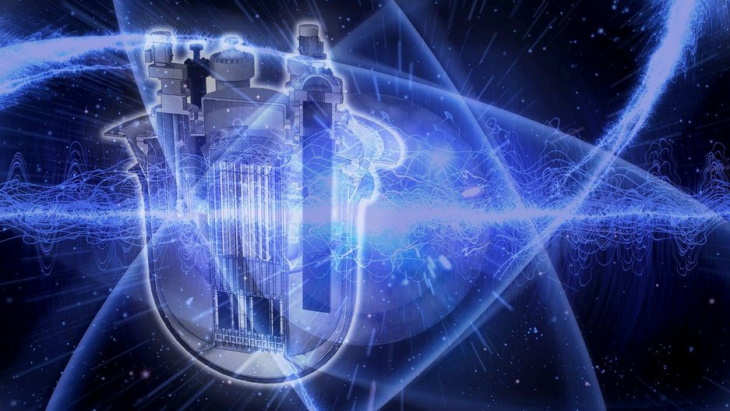 www.world-nuclear-news.org
www.world-nuclear-news.org
The European Commission has selected nine small modular reactor projects - including two lead-cooled fast reactors - in the initial round of applications to form Project Working Groups under the European Industrial Alliance on SMRs. The European Commission (EC) launched an Industrial Alliance dedicated to SMRs in February this year, aiming to facilitate the development of SMRs in Europe by the early 2030s. The Alliance works through working groups to improve the conditions for the development and deployment of SMRs, including rebuilding the supply chain for nuclear power. The activities aim to support specific SMR projects and accelerate their deployment on the European market. The EC said the initial membership call elicited responses from more than 300 stakeholders, encompassing SMR technology designers, utilities, energy-intensive users, supply chain companies, research institutes, financial institutions, and civil society organisations. The alliance members and its governing board were formally confirmed at the inaugural General Assembly in Brussels on 29-30 May. In pursuit of tangible project outcomes, in June the Alliance launched a call for SMR projects wishing to be considered for the Alliance's Project Working Groups (PWGs). Subsequently, the governing board, with the assistance of the Alliance secretariat, conducted a review and assessment of the 22 applications received. Following the second meeting of the governing board - held on 7 October - the first batch of SMR projects that would constitute the PWGs under the Alliance have been selected. They include: EU-SMR-LFR project (Ansaldo Nucleare, SCK-CEN, ENEA, RATEN); CityHeat project (Calogena, Steady Energy); Project Quantum (Last Energy); European LFR AS Project (Newcleo); Nuward (EDF); European BWRX-300 SMR (OSGE); Rolls-Royce SMR (Rolls-Royce SMR Ltd); NuScale VOYGR SMR (RoPower Nuclear SA); and Thorizon One project (Thorizon). "Each of these projects will have the opportunity to constitute a PWG involving all partners interested in collaboration with the project," the EC said. Lead-cooled fast reactors Commenting on the selection of the EU-SMR-LFR project, Marc Schyns, director of innovative nuclear systems at the Belgian Nuclear Research Centre (SCK-CEN), said: "Our project is getting a label – a vote of confidence from Europe. This will give a huge boost to the partners working on this; it only further strengthens our ambition to demonstrate the potential of lead-cooled, fast reactor technology." Project partner Ansaldo Nucleare added: "The development path, which has been awarded by the European Commission, includes the construction of two demonstration prototypes (LEANDREA and FALCON) designed to validate the technological choices, which will be built in Belgium and Romania, respectively." Newcleo CEO Stefano Buono said the selection of the company's LFR AS project was a "ringing endorsement" for its technology. "We look forward to collaborating with the new European Commission Commissioner and other industry stakeholders, who, like us, are members of the European Industrial Alliance of SMRs, to foster a supportive environment for the growth of new nuclear technologies," he added. Ansaldo Nucleare noted, "The four future partners Ansaldo Nucleare, ENEA, RATEN and SCK-CEN have signed a collaboration agreement, together with Newcleo. This will launch discussions to see how we can work together and where the two consortiums can collaborate on LFR technology. By joining forces, we are enhancing our shared commitment to innovation and sustainability within the nuclear sector and can further promote the development of fast reactor technology in Europe." The EC said most of the other projects that applied in the first assessment round and were not selected in the first batch of SMR projects will have the opportunity to submit a new application in the next round, which is expected to be organised in the second quarter of 2025.
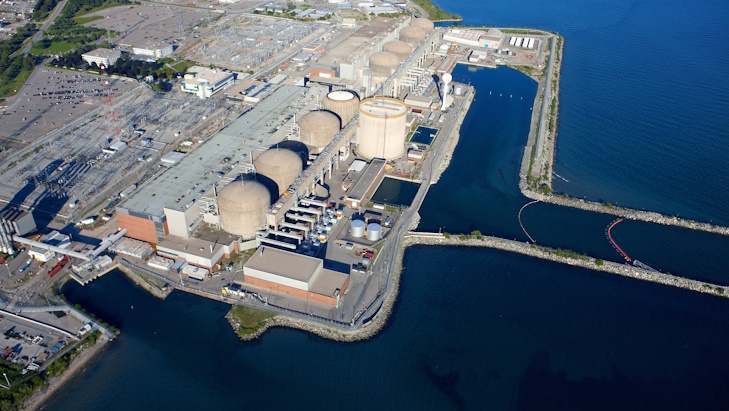 www.world-nuclear-news.org
www.world-nuclear-news.org
The Canadian Nuclear Safety Commission has approved Ontario Power Generation's request to continue operating Pickering units 5-8 to the end of 2026, ensuring the units can continue in operation until they are taken offline for refurbishment. Unit 1 ceased commercial operations on 30 September and unit 4 will close by the end of this year. Submissions from Ontario Power Generation (OPG), Canadian Nuclear Safety Commission (CNSC) staff and 54 intervenors during a public hearing in Pickering in June 2024 were considered by CNSC before authorising the units to operate until 31 December 2026, up to a maximum of 305,000 equivalent full power hours (EFPH). OPG was previously authorised to operate the units until 31 December this year, up to a maximum of 295,000 EFPH. The amended licence includes a new condition requiring OPG to implement and maintain an enhanced fitness-for-service programme, the CNSC said. OPG's Pickering Nuclear Generating Station comprises two reactor facilities with a total of eight Candu reactor units. Units 5-8 - sometimes referred to as Pickering B - began operating between 1983 and 1986. Units 1 and 4 - part of the four-unit Pickering A plant which began operations in the early 1970s and was laid up in 1997 - underwent refurbishment before returning to service in the 2003 (unit 4) and 2005 (unit 1). Pickering unit 1 was taken offline and out of service on 30 September as planned, and will now be dewatered and placed in safe storage. Unit 4 will be taken out of service at the end of December, as OPG continues to plan for the refurbishment of units 5-8. The CNSC's decision will help meet Ontario’s rising need for electricity, particularly as the province's other nuclear stations undergo refurbishment, OPG said. "This is another great milestone for Pickering Nuclear and all our station staff, who have worked hard to help Pickering achieve some of its best performance in its history in recent years," OPG Chief Nuclear Officer Steve Gregoris said. Plans to refurbish units 5-8 were formalised at the start of this year, when the provincial government announced its support for the project. OPG's timeline envisages putting the entire station into a "layup state" in 2026 so that refurbishment activities can begin. All four refurbished reactors will be back in service by the mid-2030s. OPG is currently refurbishing four Candu units at its Darlington site, aiming to complete the project in 2026, and is also planning to build up to four BWRX-300 small modular reactors (SMRs) at its Darlington New Nuclear project.
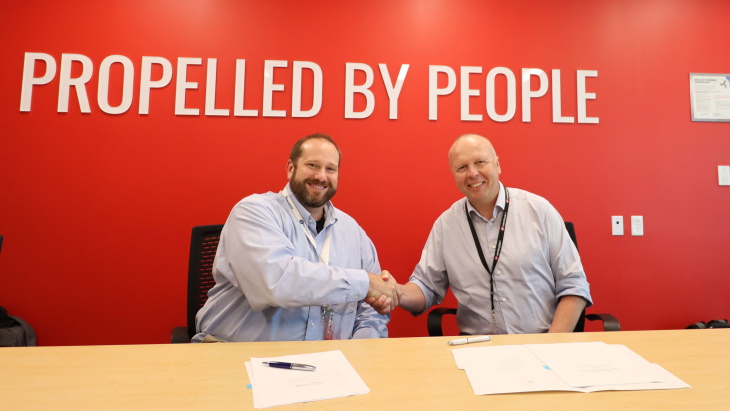 www.world-nuclear-news.org
www.world-nuclear-news.org
Vancouver-based shipbuilding firm Seaspan ULC has been selected by Westinghouse to supply components for its AP1000 and AP300 reactors, while Montreal-based Velan Inc will supply valves to GE Hitachi Nuclear Energy for its first BWRX-300 small modular reactor. Westinghouse and Seaspan ULC announced they have signed a memorandum of understanding to support nuclear new-build projects in Canada and around the world. Under the agreement, Seaspan has the potential to manufacture key AP1000 and AP300 reactor components, including pipe spools and steel structures. With three shipyards in British Columbia and a dedicated workforce of 4000 employees, Seaspan is a leader in shipbuilding, maintenance, and ship repair with experience in delivering complex manufacturing projects. "This aligns well with the requirements of large-scale capital projects such as AP1000 and AP300 reactors," Westinghouse said. "Seaspan's proven experience in custom, high-quality fabrication and manufacturing in support of both our large shipbuilding and our complex repair and overhaul projects has positioned Seaspan to pursue work in adjacent markets, such as the nuclear industry," said Dave Hargreaves, senior vice president of strategy, business development and communications at Seaspan Shipyards. "We look forward to working with Westinghouse to deliver this new capability." "We are proud to establish this new relationship with Seaspan and bring them into our network of more than 450 Canadian suppliers," said Westinghouse Energy Systems President Dan Lipman. "Seaspan's manufacturing expertise and ability to deliver on large-scale projects will make it a valuable partner to support advanced reactor projects in Canada and beyond." Meanwhile, GE Hitachi Nuclear Energy (GEH) announced it has selected Velan Inc to provide engineering support and manufacture valves for the first BWRX-300 small modular reactor (SMR). "Our collaboration with Velan will further strengthen the robust and experienced Canadian nuclear supply chain and bring economic benefits to the country," said Sean Sexstone, executive vice president, advanced nuclear, GEH. "It also positions Velan to be a strategic supplier as our technology is deployed globally. We will continue to look for opportunities to work with Canadian suppliers to support the deployment of the BWRX-300." "Velan's involvement in this project highlights our decades-long leadership in the nuclear power sector," said Velan Chairman and CEO James Mannebach. "As we approach our 75th anniversary in 2025, we are remarkably well-positioned to support this landmark project and help shape the future of Canada's nuclear energy landscape through small modular reactor technology." GEH and Ontario Power Generation are developing the first BWRX-300 at OPG's Darlington site. Early site preparation work has been completed with construction expected to start in 2025 and commercial operation to commence by the end of 2029. A total of four 300 MWe units are planned for the Darlington site.
 www.world-nuclear-news.org
www.world-nuclear-news.org
Uranium enrichment services provider Urenco has installed the first new centrifuges as part of an expansion of its plant in Eunice, New Mexico. Meanwhile, Orano has laid the foundation stone of the extension of its Georges Besse 2 plant in France. Urenco announced plans in July 2023 to increase capacity at its Eunice plant - the only operating commercial uranium enrichment facility in North America - by 15%. New commitments from US customers for non-Russian fuel underpin this investment, the company noted. It said the project would see multiple new centrifuge cascades added to the existing Urenco USA (UUSA) plant. The expansion of the plant - operated by Louisiana Energy Services LLC (LES) - will provide an additional capacity of around 700 tonnes of separative work units (SWU) per year, with the first new cascades due online in 2025. The plant currently has a production capacity of 4600 tSWU per year. Urenco has now installed the first new centrifuges in an existing centrifuge hall at the site. It said federal, state and local officials, Urenco leadership, representatives of the more than 500 UUSA employees and contractors, and members of the community gathered at the facility on 9 October to mark the occasion. Urenco said it is on schedule to begin producing enriched uranium from newly installed centrifuges in 2025. "Our enrichment site in Eunice is ideally located to serve our US customers and the wider global market to help meet energy security and decarbonisation goals," said Urenco CEO Boris Schucht. "This facility has successfully operated for more than a decade and the expansion is further proof of the domestic supply it consistently delivers. "This is only the latest step. We are intending to further expand our capacity in the US, subject to market needs, as the strong momentum in the nuclear industry continues. This will not only mean an even stronger US nuclear fuel supply chain, but more jobs, skills, and development so we can continue to attract and retain the next generation of operators, engineers and scientists for the future of this industry." The Eunice site's expansion project, scheduled for completion in 2027, is the first to be delivered under Urenco's capacity expansion programme, and will strengthen the nuclear fuel supply chain both in the USA and globally. Urenco also operates three enrichment facilities in Europe: at Capenhurst in the UK, Almelo in the Netherlands and Gronau in Germany. In total, under Urenco's current expansion, 1.8 million SWU will be delivered across three projects, including two others at Urenco's sites in Germany and the Netherlands. Expansion of French plant Orano held a ceremony on 10 October to mark the laying of the foundation stone of the Georges Besse 2 (GB-II) plant extension at the Tricastin site in France. The GB-II centrifuge enrichment plant - which superseded the Georges Besse I gaseous diffusion enrichment plant that ended production in June 2012 - was officially opened in December 2010 and reached its full production capacity of 7.5 million SWU in 2016. In October 2023, the board of directors of Orano approved an investment of some EUR1.7 billion (USD1.9 billion) to raise the production capacity of the plant by more than 30%. The project consists of building a further four modules identical to the fourteen existing modules that use "the same recognised, tried-and-tested technology and with a reduced environmental footprint", the company said. The additional cascades will increase the plant's capacity by 2.5 million SWU. The new modules are expected to begin operating in 2028, with complete commissioning of the extension in 2030. Nicolas Maes said: "The project which is taking shape here today is one of the five most important industrial projects underway in France today. It is an important step in Orano's development. "Thanks to this expansion of our capacity, we will strengthen the supply chain of our utility customers and in particular, for many of them, make them less sensitive to geopolitical risks. The production of the plant will enable nearly 120 million homes to be supplied with low-carbon electricity and contribute to fighting global warming." In early September, Orano USA announced it had selected Oak Ridge as its preferred site for a new centrifuge uranium enrichment facility. Orano's forerunner company Areva had previously planned to build the Eagle Rock centrifuge plant at Idaho Falls. That plant was originally envisaged as a 3.3 million SWU per year plant with the company later applying to the US regulators to double its capacity to 6.6 million SWU. It was subsequently cancelled, and Orano requested the US Nuclear Regulatory Commission to terminate its licence for the plant in 2018.
 www.nucnet.org
www.nucnet.org
French nuclear company Framatome has been selected by Spanish operator Centrales Nucleares Almaraz-Trillo (CNAT) for the long-term supply of high thermal performance (HTP) fuel assemblies and related services to Unit 1 of the Trillo nuclear power station in Spain. The contract covers a total of nine fuel assembly deliveries and related services from 2026-2035. The contract can be extended beyond 2035 should the lifetime of the Trillo nuclear power plant be extended. HTP denotes a fuel assembly design in which a specific Framatome-developed spacer grid is a major component. HTP fuel assemblies have been loaded into 45 reactors across the globe. Framatome, owned by EDF and Mitsubishi Heavy Industries, is the original equipment manufacturer of the plant and has been supplying fuel assemblies, engineering, and field services since its startup in 1988. Trillo-1, a 1,003-MW pressurised water reactor unit in Guadalajara province, central Spain, began commercial operation in August 1988. Its current licence expires in November 2024, but CNAT submitted a renewal application to the government last year for operation until 2034.
 www.nucnet.org
www.nucnet.org
Power utility EDF has begun a major overhaul of the Sizewell B nuclear power station in southeast England with work set to cost £75m (€65m, $71m) and take around two months. During the outage teams at Sizewell B – which is due to close in 2035, but could operate until 2055 – will carry out work that includes replacing a high-pressure rotor and three low pressure rotors in one of the station's turbine generators and replacing about a third of the fuel assemblies in the reactor. EDF said workers will carry out detailed inspections of reactor systems and examine high pressure pipework across the reactor system. Every 18 months teams at Sizewell B take the site’s nuclear reactor offline for refuelling and other works designed to improve the efficiency of the plant’s operations. During the outage EDF will bring in more than 1,000 extra staff to perform more than 12,000 tasks. The reactor, which every year generates enough zero-carbon electricity to meet the needs of more than 2.5 million homes, was taken offline on 11 October. Sizewell B is a 1,198 MW pressurised water reactor unit that began commercial operation in September 1995. EDF acquired the UK nuclear fleet, which has nine units in operation at five sites, in 2009 and, since then, has invested around £1.2bn in Sizewell B to maintain reliability. Sizewell B is due to generate electricity until 2035, but EDF is considering plans to keep it operational until 2055. The company said there is no immediate need to make a final investment decision on long-term operation. “As well as finalising the technical case, we are seeking greater cost certainty and confidence in the long-term commercial case to enable a final investment decision when ready,” a statement said. EDF has said there is an “obvious case” for extending the life of Sizewell B, but it needs a government framework to enable it to make a decision.
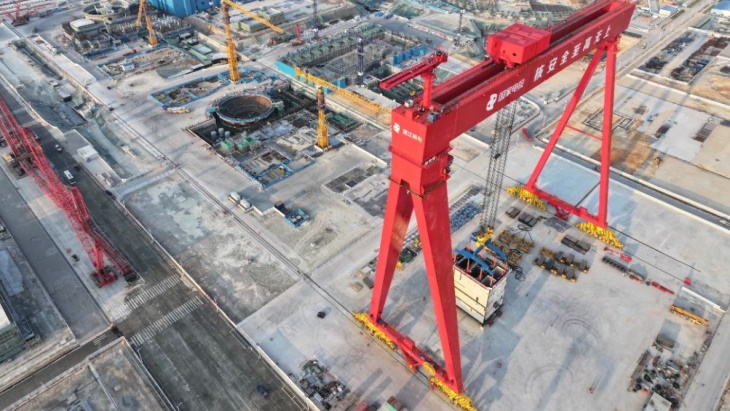 www.world-nuclear-news.org
www.world-nuclear-news.org
The CA20 module - measuring 20.6 metres in length, 14.2 metres in width and with a height of 21 metres - has been hoisted into place at the second unit of the Lianjiang nuclear power plant in China's Guangdong province. The cuboid-shaped CA20 module - weighing just over 1000 tonnes - consists of 32 wall modules and 39 floor modules. It will comprise plant and equipment for used fuel storage, transmission, the heat exchanger and waste collection, among other things. Installation of the module means that construction continues to progress at the two CAP1000 units planned as the initial phase of the plant, which will eventually house six such reactors. The construction of the first two 1250 MWe CAP1000 reactors - the Chinese version of the Westinghouse AP1000 - at the Lianjiang site was approved by China's State Council in September 2022. Excavation works for the units began in the same month, with the pouring of first concrete for the foundation of unit 1 completed at the end of September last year. First concrete for unit 2 was poured on 26 April this year. Lianjiang unit 1 is expected to be completed and put into operation in 2028, with unit 2 following in 2029. Once all six CAP1000 units at the site are completed, the annual power generation will be about 70.2 TWh, which will reduce standard coal consumption by over 20 million tonnes, and reduce carbon dioxide emissions by over 52 million tonnes, sulphur dioxide by about 171,000 tonnes and nitrogen oxides by about 149,000 tonnes. State Power Investment Corp (SPIC) says the Lianjiang plant will be the first nuclear power project in China to adopt seawater secondary circulation cooling technology as well as the first to use a super-large cooling tower.
 www.nucnet.org
www.nucnet.org
Slovak power utility Slovenske Elektrarne and its partners have received a US government grant of $5m (€4.5m) to support the selection of the best site for the construction of small modular reactors (SMRs) in the European country The award is part of the US government-funded programme aiming to finance activities that will help countries to decide on, and prepare for SMR programmes. It follows on from a separate US government scheme, Project Phoenix, which awarded $2m last year to fund feasibility studies into the potential for SMRs in Slovakia on the sites of former coal-fired power plants. The grant will go towards consulting services around the technical and regulatory requirements for SMRs, cooperation with universities and nuclear facilities and strategies for the deployment of SMRs. Slovenske Elektrarne said: “After the selection of the most suitable location… it will be necessary to carry out in-depth surveys on the site, which will ensure a clear and continuous path in the implementation of the SMR plan.” Slovenske Elektrarne chairman and general manager Branislav Strycek said the demand for electricity in Slovakia will grow. “Small modular reactors are not intended to replace our existing nuclear resources, which cover most of the consumption in Slovakia safely, reliably and without direct CO2 emissions,” he said. “SMRs are intended to complement the energy mix for the country’s energy self-sufficiency in the future. “The grant we received through international competition is great news. It gives us the opportunity to accelerate project preparations that are important for the success of our energy transformation.” Earlier this year Slovakia’s prime minister Robert Fico said the Slovak government was set to approve the development of an additional large-scale 1,200 MW nuclear power unit. Slovakia has five commercial nuclear reactor units – three at Mochovce in southwest Slovakia and two at Bohunice in the west of the country – all of the Russia-designed VVER-440 pressurised water reactor type. The country’s latest unit, Mochovce-3, completed commissioning at the end of 2023. An identical unit, Mochovce-4, remains under construction. The fleet has been generating about 59% of the country’s electricity. Mochovce-3 will bring the share of nuclear in the country’s electricity generation to about 65%, putting it second behind only France.
 www.world-nuclear-news.org
www.world-nuclear-news.org
Small modular reactors offer a promising solution to the energy challenges in the data centre sector and power from advanced nuclear technologies could revolutionise the energy landscape - but educating decision makers is critical to advancing their deployment, according to a white paper from global industrial technology company Schneider Electric. Data centres are central to driving the electrification and digitisation of the global economy, and have been the primary instruments of the increased adoption of artificial intelligence (AI), authors Marcin Wegrzyn and Steven Carlini say in Small Modular Nuclear Reactors Suitability for Data Centers. However, they are impacting energy demand in unprecedented ways. Data centres are "singularly focused on reducing their own carbon footprint", looking at multiple paths forward including increasing use of renewable energy and the introduction of efficient cooling technologies. But consistent power availability is becoming a serious concern, and sourcing local power is a challenge, with power purchase agreements (PPA) that were initially designed to drive adoption of renewables falling short of closing the gap between demand and availability. "The sector needs alternatives. Nuclear can fill the gap," the paper says. As the demand for energy-efficient, reliable and sustainable power solutions for data centres continues to grow, small modular reactors (SMRs) "continue to emerge as a promising alternative to current constraints", the paper says, offering a "compelling mix of lower capital costs, shorter deployment times and significant environmental benefits". They offer the potential for reliable, low-carbon energy supply to data centres, with the potential for enhanced operational safety and improved energy resiliency compared to renewable alternatives, while their scalable design and advanced risk mitigation protocols may offer reduced environmental impacts. However, it notes, SMRs "are still unproven at scale". The paper sets out a list of considerations would-be adopters of SMRs for data centres should bear in mind when determining whether the technology would meet the needs of their project. These include, amongst other things: power needs, including prime and back-up power; availability options including regulatory restrictions; safety, siting and security assessments; time to deployment including regulatory approvals and construction; and environmental and sustainability considerations. "SMR technology has matured, and their safety and reliability claims have data centre operators intrigued," the paper concludes. "While there is much excitement for the technology, it must be proven before regulators allow for mass deployments." It goes on to note that "the industry is in the process of establishing an optimised deployment model allowing for effective adoption of modular technology in the data centre industry." "Where modular reactors can work best is in concert with renewable resources as a complementary generation technology for green power. Additionally, and it goes without saying, every new technology requires a thorough vetting. In this case, an SMR evaluation would also include a security and risk assessment, as dictated by the data centre operator and its partners to address any local and national concerns," it adds. The data centre industry "will need to consider higher upfront costs" for nuclear but it is the "most realistic path" to meeting sustainability commitments, the paper says. "Safe and resilient reactors deployed onsite or as grid infrastructure may be a remedy to power shortages if regulatory and manufacturing regimes become standardised across geographies." Earlier this year, SMR developer Terrestrial Energy signed an agreement with Schneider to collaborate on developing zero-carbon energy solutions for industrial facilities and large data centres based on Terrestrial's Integral Molten Salt Reactor.
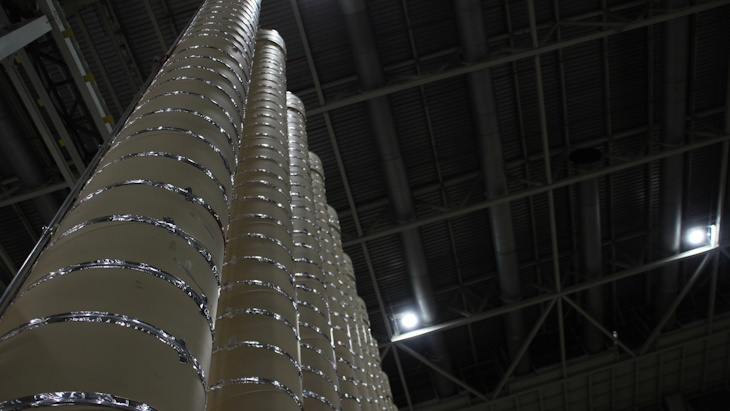 www.world-nuclear-news.org
www.world-nuclear-news.org
Six companies have been awarded contracts worth a minimum of USD2 million each to provide deconversion services, a critical part of the supply chain for high-assay low-enriched uranium. The US Department of Energy (DOE) has awarded contracts to BWXT, Centrus, Framatome, GE Vernova, Orano and Westinghouse. The contracts will last for up to 10 years, with up to USD800 million available in total for these services, subject to the availability of appropriations, and will create "strong competition" allowing DOE to select the best fit for future work, it said. High-assay low-enriched uranium (HALEU) is uranium enriched to between 5% and 20% uranium-235. It will be used in the advanced nuclear fuel required for most of the next-generation reactor designs currently under development. But the USA does not have the commercial HALEU enrichment and deconversion services to support the deployment of advanced reactors, which DOE says are essential to meeting its greenhouse gas reduction and climate goals. The DOE is pursuing several pathways to secure a domestic supply of HALEU: The Energy Act of 2020 directed the establishment of the HALEU Availability Program to ensure access to HALEU for civilian domestic research, development, demonstration, and commercial use. Deconversion involves transforming the gaseous uranium hexafluoride which has undergone enrichment into oxide or metal forms that are fabricated into fuel for advanced reactors, and is a critical part of the HALEU supply chain. Building a strong, reliable domestic nuclear fuel supply chain will help the USA reach its climate goals while also protecting the environment and creating good-paying, high-quality jobs, Deputy Secretary of Energy David Turk said. "Today's announcement underscores the Biden-Harris Administration's continued commitment to strengthening our energy and national security by our eliminating America's reliance on Russian uranium for civil nuclear power," he added. Russia and China are the only countries that currently have the infrastructure to produce HALEU at scale. Orano said its team brings together the capabilities and experience of its affiliates, led by Orano Federal Services with teaming partners including Fluor, Spectra Tech, Shine Technologies and others. "Our team of expert companies represents the full range of capabilities needed for success and certainty of project delivery, plus the benefits from our strong relationships with community partners. With the US goal of tripling nuclear energy by 2050, we need this active focus on developing a secure domestic fuel supply for all reactors," Orano USA CEO Jean-Luc Palayer said. The HALEU acquired through these contracts will be used to support reactors such as TerraPower's Natrium reactor and X-energy's Xe-100, which are being developed through DOEs Advanced Reactor Demonstration Program. DOE said it also plans to award contracts for enrichment services to support the full breadth of the HALEU supply chain. The US Inflation Reduction Act - signed into law in 2022 - included a USD700 million support package to support the development of a domestic HALEU supply chain, and the US Administration's 2025 budget request submitted to Congress in March this year included USD188 million to secure a near-term supply of HALEU.
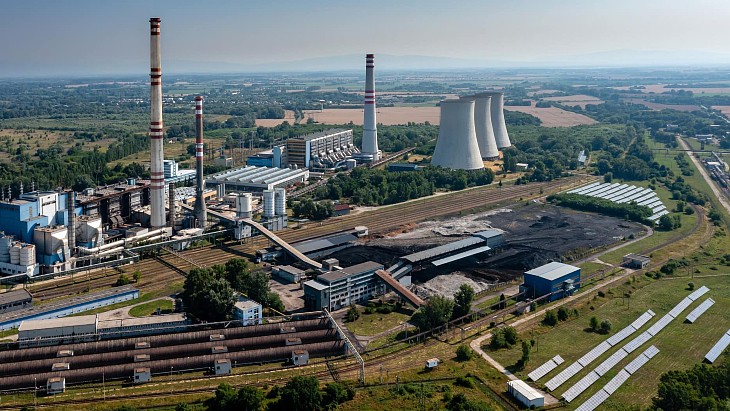 www.world-nuclear-news.org
www.world-nuclear-news.org
Slovakia has been awarded a grant from the USA's Nuclear Expediting the Energy Transition (NEXT) project for help in selecting a site for the construction of small modular reactors in the country. The award is part of the US government-funded programme aiming to finance activities that will help countries to decide on, and prepare for small modular reactor (SMR) programmes. This grant follows on from a separate US government scheme - Project Phoenix - which awarded USD2 million last year to fund feasibility studies into the potential for SMRs in Slovakia on the sites of former coal-fired power plants. The NEXT programme was announced by the Presidential Envoy for Climate John Kerry at the Three Seas Initiative Summit in Bucharest, Romania in September 2023. It provides technical assistance to eligible partner countries and "aims to provide technical support to partner countries that are exploring emerging clean nuclear energy technologies in a manner that makes them more affordable and accessible while adhering from the outset to the highest standards of nuclear security, safety, and nonproliferation". Slovakia's Deputy Prime Minister and Economy Minister Denisa Saková described being selected for the grant as a "great and significant success", saying: "Nuclear and nuclear energy are the most important topics in the energy sector, because they will significantly help us to decarbonise our industry, contribute to climate goals, but especially to ensure Slovakia's energy security and independence." Slovenské elektrární CEO Branislav Strýček said: "The demand for electricity will grow. Small modular reactors are not intended to replace our existing nuclear sources, which safely, reliably and without direct CO2 emissions cover the majority of consumption in Slovakia. SMRs are supposed to be a supplement to the energy mix for the energy self-sufficiency of the country in the future. The grant we won in international competition is great news. It gives us opportunities to accelerate the preparation of projects that are important for the success of our energy transformation." The joint bid included the economy ministry, nuclear operater Slovenské elektrární, the Slovak Technical University, the Office for Nuclear Supervision, the Slovak Electricity and Transmission System, engineering company VUJE and US Steel Košice. The range of activities supported by the grant includes consulting services around the technical and regulatory requirements for SMRs, cooperation with universities and nuclear facilities. Slovenské elektrární said: "After the selection of the most suitable location ... it will be necessary to carry out in-depth surveys on the site, which will ensure a clear and continuous path in the implementation of the SMR plan. All partners in this process want to achieve a level of knowledge that will help them support the country's goals in building SMRs, establishing academic partnerships, technical advice, and visits to specific US facilities." Nuclear power in Slovakia Slovakia currently has five nuclear reactors - three at Mochovce and two at Bohunice - generating half of its electricity, and it has one more at Mochovce under construction. Both plants are operated by Slovenské elektrární. In February last year Jadrová Energetická Spoločnosť Slovenska (JESS) submitted a request to the Slovak Nuclear Regulatory Authority (ÚJD) for a siting permit for a new nuclear power plant near the existing Bohunice plant in Jaslovské Bohunice, a small village in the west of the Slovak Republic. JESS - a joint venture between Slovak state-owned radioactive waste management company JAVYS (51%) and Czech utility ČEZ (49%) - was formed in December 2009 to build and operate a new nuclear power plant at Bohunice. JESS is responsible for the preparation of the New Nuclear Resource Project (NJZ) and, "as part of the activities of the pre-preparation stage and in accordance with the approved Business Plan for the NJZ Project for the period 2022-2025, processed the necessary documentation for the written application for a permit for the location of a nuclear facility". At the time of submitting the siting permit application JESS said it planned to apply for a construction licence for the plant at the end of 2025 with construction work scheduled to start in 2031.
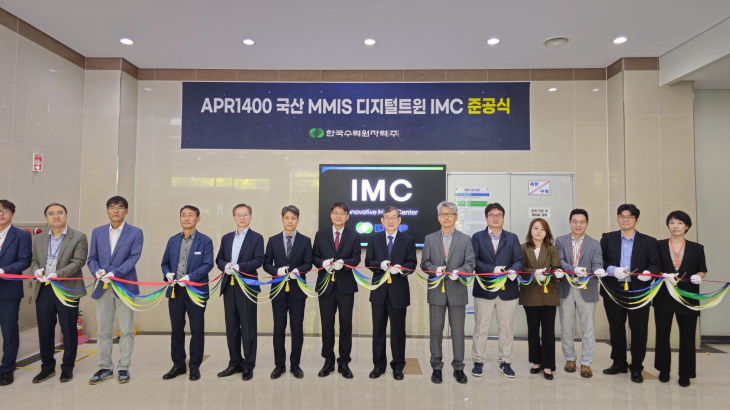 www.world-nuclear-news.org
www.world-nuclear-news.org
After four years of research, Korea Hydro & Nuclear Power has completed the development of a digital twin of the Man-Machine Interface System for the control room and instrumentation & control system of the APR1400 reactor. It expects this to "greatly contribute to the reliability and safety of nuclear power generation". KHNP completed the construction of its Innovative MMIS Centre at the KHNP Central Research Institute in Daejeon, South Korea. It is equipped with Man-Machine Interface System (MMIS) digital twin virtualisation facilities. The company said this centre "is expected to contribute as an advance base for the MMIS digital twin simulator included in the Czech new nuclear power plant construction project, for which KHNP has been selected as the preferred bidder". The MMIS digital twin for the APR1400 is characterised by implementing the safety and non-safety system controllers of nuclear power plants identical to actual equipment through full virtualisation, which KHNP says is more advanced than existing object-based twins. "Using this newly developed technology, performing simulation of all processes from power plant construction to operation becomes possible," KHNP said. "In the power plant construction phase, design verification can be performed, and in the operation phase, it can be of a great help in performing root cause analysis when events such as failures occur. "For example, when utilising the MMIS digital twin, various scenarios possible in a power plant can be simulated to test various control systems, and problem-solving ability and maintenance efficiency can be improved through smart engineering functions, real-time monitoring of controllers, and data analysis functions." KHNP Research Institute Director Ho-cheol Shin said: "Our Korean MMIS digital twin for APR1400 will further enhance the safety of nuclear power plants, and it is expected to also further increase our export competitiveness." South Korea has four operational APR1400 units - Saeul units 1 and 2 (formerly Shin Kori 3 and 4) and Shin Hanul units 1 and 2. Two further APR1400s are under construction as Saeul units 3 and 4. Construction permits for APR1400 units at Shin Hanul units 3 and 4 were granted last month. Four APR1400 units have also been built at the Barakah nuclear power plant in the UAE, which are all now in commercial operation.
 www.nucnet.org
www.nucnet.org
Four companies have been chosen as awardees under an $800m (€730m) US Department of Energy (DOE) contract to provide high-assay low-enriched uranium (Haleu) deconversion services for advanced nuclear power reactors. According to a notice published by the DOE, the four companies are Nuclear Fuel Services, Global Nuclear Fuel-Americas, American Centrifuge Operating and Framatome. In November 2023, the DOE issued a solicitation for the potential 10-year contract to deconvert Haleu to produce fuels for advanced reactors. Each awardee will receive a minimum guarantee of $2m and conduct deconversion and storage services at locations within the continental US. The work could involve deconverting uranium hexafluoride gas to a metal and oxide that will be transported and stored until there is a need for it to be manufactured into fuel for advanced nuclear reactors. Framatome said in a statement that the DOE contract is to provide deconversion services for Haleu production for new domestic capacity “in support of the mission of nuclear energy”. It said deconversion services include the design, licensing and construction of production facilities and the production of oxide and metal Haleu product. Haleu is enriched uranium with the concentration of fissile isotope U-235 above 10% and below 20% of the total mass. Since the standard enrichments for the current US light-water reactor nuclear fleet are below 5%, Haleu is an essential component for the future of advancing nuclear technology in the US and around the world, Framatome said.
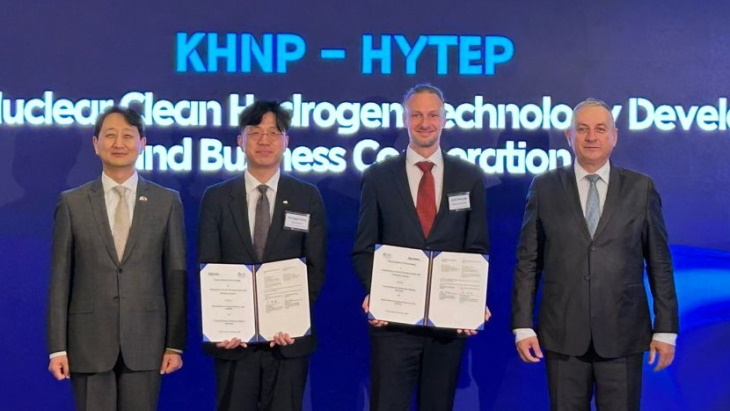 www.world-nuclear-news.org
www.world-nuclear-news.org
Korea Hydro & Nuclear Power (KHNP) has agreed to cooperate with Hydrogen Technology Platform (HYTEP) on the development and exchange of information on the production of hydrogen, including through the use of nuclear technology. According to the MoU - signed during the Korea-Czech Industry & Energy Technology Cooperation Forum in Prague on 20 September - KHNP and HYTEP will strengthen their competitiveness in the global clean hydrogen market by actively cooperating in the following areas: nuclear clean hydrogen technology development and business cooperation, technology development and business support in other hydrogen fields (including fuel cells); and improvement of hydrogen policy and regulations and information exchange (such as forums and seminars). In particular, with the common goal of global clean energy transition, the partners agreed to closely cooperate in building clean hydrogen infrastructure and developing hydrogen technology in Europe. KHNP said it plans to "fully enter the European clean hydrogen business based on its technological capabilities and business capacities accumulated in Korea". "This cooperation will be an opportunity for our country to gain global competitiveness in the clean hydrogen industry," said Young-gon Kong, head of KHNP's H2 & Smart Business Department. "Based on the hydrogen-related technology and passion we have built up in Korea, we will do our best to achieve the best results in the European market in cooperation with Czechia." HYTEP was initiated in 2006 by the Czech Ministry of Industry and Trade aimed at creating a tool to support mutual awareness of bodies active in the area of hydrogen technologies and to coordinate activities related to the development of these applications. Most hydrogen today is made by steam reforming of natural gas or coal gasification, both with carbon dioxide emissions. Future demand will be mainly for zero-carbon hydrogen. Plans for increased hydrogen production are essentially based on electrolysis using electricity from intermittent renewable sources. Off-peak capacity of conventional nuclear reactors or other power plants can also be used. In future, a major possibility for zero-carbon hydrogen production is decomposition of water by direct use of heat from nuclear energy, using a thermochemical process enabled by high-temperature reactors.
 www.world-nuclear-news.org
www.world-nuclear-news.org
Lotus Resources says it can reopen the Kayelekera uranium mine in Malawi in 8-10 months - much quicker than its previous 15 month estimate. It is now targeting production in the third quarter of 2025. The accelerated restart plan, which follows the completion of a Front-end Engineering and Design (FEED) programme, targets production of 19.3 million pounds U3O8 over a 10-year mine life. Lotus is now moving into detailed engineering and onsite works for Kayelekera’s restart. The accelerated restart is made possible by taking a phased approach to both the completion of on-site infrastructure and to restart capital, and is derisked by 11 million pounds U3O8 of historical uranium production, with USD200 million already invested into the plant and operations and existing stockpiles to support the ramp-up of the operation. The company's board has already approved long lead item orders, mobilisation of mobile equipment and construction crews and early works. It has been able to proceed with the restart using AUD34 million (USD23 million) of existing cash funding (as of 30 June). In parallel with this, it is also continuing to assess an "optimal funding mix" of funding from debt, prepayment sources, commodity finance, strategic and cornerstone funding sources, and expects restart, post production and working capital to come from a mix of these sources, as well as from the cashflow from operations. CEO Greg Bittar said the FEED process has provided the foundation for Lotus to optimise and accelerate its restart plans, taking advantage of the existing plant and infrastructure. "By sequencing the capital spend and targeting the critical restart items we reduce the amount of initial restart capital, which allows us to turn the plant on much earlier than previously contemplated. This not only provides us with increased funding flexibility but critically allows us to be a producer next year and take advantage of the strong customer demand we are seeing by moving into production as soon as possible," he said. "By decoupling the restart timetable from the long lead items which are not on the operational critical path, principally the connection to the power grid and acid plant rebuild, we are able to start the plant well ahead of the original DFS schedule of 15 months." Those capital items remain in the plan, but "we don’t need to wait for those, or have the timetable to restart dependent on those, items," Bittar added. "The plan was always to have full back up diesel power generation, as the site was originally operated by, and we can use this power while the grid connection is completed. Trucked-in sulphuric acid can be used until the acid plant is commissioned." Kayelekera is 85% owned by Australian company Lotus, which acquired it from Paladin Energy in 2020. It produced around 11 million pounds U3O8 between 2009 and 2014, when it was placed on care and maintenance, and has total resources of 51.1 million pounds including 4.8 million pounds of inferred resources at the Livingstonia deposit. Lotus announced inaugural mineral resources for the deposit, which is a potential satellite operation to Kayelekera, in June 2022.
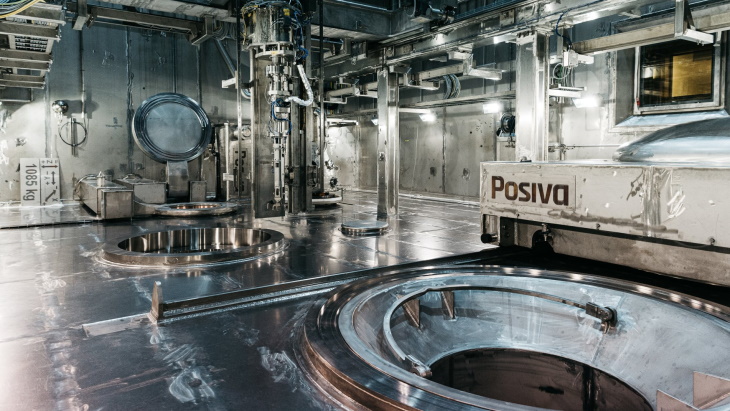 www.world-nuclear-news.org
www.world-nuclear-news.org
The first canister has been packed successfully with test elements simulating actual fuel in the ongoing trial run of final disposal at the Onkalo used nuclear fuel repository, Finnish waste management company Posiva has announced. At the repository, used fuel will be placed in the bedrock, at a depth of about 430 metres. The disposal system consists of a tightly sealed iron-copper canister, a bentonite buffer enclosing the canister, a tunnel backfilling material made of swellable clay, the seal structures of the tunnels and premises, and the enclosing rock. Posiva announced in late August the start of a trial run - expected to take several months - of the operation of the final disposal facility, albeit still without the used fuel. Four cannisters are to be deposited in holes which are eight metres deep and located in a 70-metres long final disposal tunnel. The final disposal tunnel will then be filled with bentonite clay and sealed with a concrete plug. The trial run also covers the retrieval of a damaged cannister back above ground. Posiva noted that the equipment and systems of the final disposal facility will be tested together for the first time in accordance with planned processes during the trial run stage. The first two encapsulations were carried out using only weights. In this third trial, elements looking like actual fuel were packed inside the canister. The used nuclear fuel is placed in the final disposal canister made of copper and spheroidal graphite cast iron. This takes place in the fuel handling cell which features concrete walls that are about 1.3 metres thick. After all the fuel assemblies have been placed in the canister, it is filled with Argon and closed tightly with the inner steel lid. The fuel assemblies are not disassembled. The weight of one fuel assembly is about a quarter of a tonne. The topmost copper lid of the canister is sealed by friction stir welding in the welding chamber and the leak-tightness of the joint is verified by means of visual as well as eddy current and ultrasound inspections. Posiva said the sealing joint produced by the selected friction stir welding method has an integrity comparable to that of the canister mantle. The first three canisters have also undergone the welding and machining processes successfully in the trial run. The trial run now proceeds to the packing and sealing of the fourth canister. The encapsulation plant is connected to the underground final disposal repository with a canister lift which transports the canisters down to the underground reception station on the final disposal level at a depth of 430 metres. There they are transferred into the deposition tunnels with the transfer and installation vehicle. Posiva has applied for an operating licence for the repository for a period from March 2024 to the end of 2070. The government will make the final decision on its application, but a positive opinion by Finland's Radiation and Nuclear Safety Authority (STUK) is required beforehand. The regulator began its review in May 2022 after concluding Posiva had provided sufficient material. The ministry had requested STUK's opinion on the application by the end of 2023. However, in January this year, STUK requested the deadline for its opinion on Posiva's operating licence application be extended until the end of 2024.